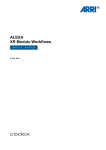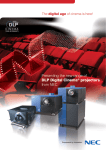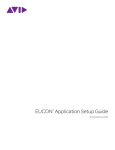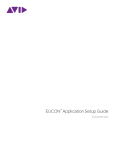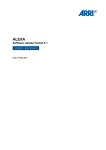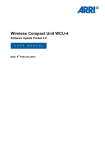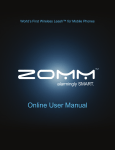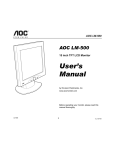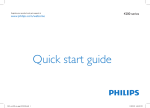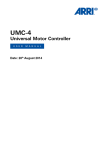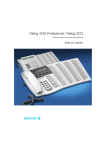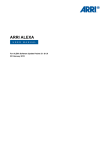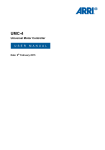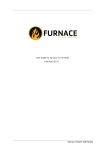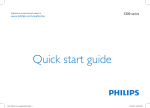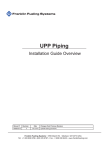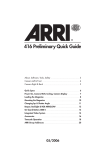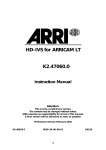Download ARRI ALEXA Pocket Guide
Transcript
Pocket Guide SUP 8.0 Table of Contents Overview Introduction The new ALEXA camera range: ALEXA XT The Home Screen Home Screen Soft Buttons Icons on Home Screen MON OUT Icons Recording Media Output Overview ARRIRAW uncompressed ARRIRAW Converter 3.0 ARRIRAW capable software solutions ProRes Recording DNxHD Exposure Index 4 4 6 8 9 12 14 16 20 22 24 25 26 28 30 Working with ND filters Precision FSNDs in comparison False Color Exposure Check Working with ALEXA Color Spaces Video - Rec 709 Log C Linear ARRI LUT Generator In-Camera Look Files Legal and Extended Range p and psf Metadata Overview Licenses 32 34 35 36 36 36 38 39 39 40 46 47 48 50 ALEXA Preshoot Checklist Recording with the XR or SxS Module Additional notes Shooting Highspeed Recording ARRIRAW via T-Link Shooting Stereo 3D ALEXA M fiber maintenance Creating Lens Tables Required Equipment Creating a Lens Table ALEXA XT/XR Workflows Compressed Recording Formats Uncompressed ARRIRAW Generating Deliverables Scaling your Workflow 52 53 55 55 55 57 57 58 59 60 64 64 64 67 69 Specifications and Reference Menu Settings & Button Functions ARRI Lenses ARRI/ZEISS Master Anamorphic Lenses ARRI/ZEISS Master Prime Lenses ARRI/ZEISS Ultra Prime Lenses ARRI/ZEISS LDS Ultra Prime Lenses ARRI/FUJINON Alura Zoom Lenses ARRI/ZEISS Master Macro Lens Annotations Resources and Contacts ARRI Sales Contacts ARRI Service Contacts ARRI Digital Workflow Solutions Online Resources 70 86 100 100 102 104 106 108 112 114 116 116 118 120 121 Table of Contents Table of Contents 2 ALEXA Pocket Guide 3 Introduction The ALEXA family Welcome to the Pocket Guide for the ALEXA and ALEXA XT family of cameras, which contains important preproduction and production information for an ALEXA shoot. The ALEXA platform has been designed with ease of use and user-friendliness in mind; the menu and controls are simple and intuitive, so the best way to learn ALEXA is to get your hands on the real thing. However, carrying this guide with you and combining it with other resources such as the ALEXA manual at www.arri.com/alexa/downloads or the interactive ALEXA/ALEXA XT Camera Simulator at www.arri.com/alexa/tools will ensure your readiness to take full advantage of the camera’s unique and versatile features. ALEXA 4 Overview Overview Overview ALEXA XT ALEXA XT M ALEXA XT Plus ALEXA XT Studio 5 The ALEXA XT brings new features to the ALEXA product line, inspired by feedback from professional users. The ALEXA XT, ALEXA XT M, ALEXA XT Plus and ALEXA XT Studio cameras replace all previous models except for the original ALEXA. Existing ALEXAs can be upgraded to deliver most of the features of an ALEXA XT. XR Module • In-camera ARRIRAW up to 120 fps • In-camera ProRes or DNxHD up to 120 fps • Fast 512 GB XR Capture Drives • Proven, efficient Codex workflows In-camera Filter Module IFM-1 • Internal filtration to reduce reflections and weight • Available in 8 densities from ND 0.3 to ND 2.4 • Neutral color balance at all densities • High image sharpness and contrast Plug and play anamorphic • 4:3 sensor on all ALEXA XT models • Anamorphic de-squeeze license included High speed license included LDS PL Mount • On all ALEXA XT models for ubiquitous lens metadata Viewfinder Mounting Bracket VMB-3 • Strong and rigid 15 mm rod construction • Can take lens motors, matte boxes, etc. • Stronger Viewfinder Extension Bracket VEB-3 Super silent ALEXA XT fan Overview Overview 6 The new ALEXA camera range: ALEXA XT 7 Home Screen Soft Buttons The soft buttons lead to screens where the respective settings can be changed. In the home screen, the following info is displayed: FPS: AUDIO: SHUTTER: EI: COLOR: 8 Set sensor frame rate hen audio is active, audio levels are W shown. Audio can also be switched OFF, or DISABLED (when the sensor is not running at sync-sound speed) Set shutter angle (and turn mirror shutter on/off for ALEXA Studio) Set exposure index (and insert internal ND filter for ALEXA Studio) Set gamma for REC OUT and SxS image paths. If REC and/or SxS icons have a blue background, a look is active on this image path. WB: et white balance, consisting of a Kelvin S value for red-blue correction and a CC shift for green-magenta correction (shown as exponent). Overview Overview The Home Screen ALEXA Studio Icons Name Icon Description Mirror Shutter M S Flashing Icon when the Mirror Shutter is spinning. View Position V Mirror Shutter in View position Gate Position G Mirror Shutter in Gate position ND filter ND ND filter active 9 TC ProRes 2K Displays active recording format (ARRIRAW, ProRes (HD or 2K) or DNxHD). isplays current timecode including D source (INT=internal or EXT=external source). Frames are not displayed, instead the time base of the timecode is shown in small digits. BAT 2 MASTER Camera is set to Ext sync: MASTER REEL SLAVE Camera is set to Ext sync: SLAVE CLIP BAT 1 Settings sync is active. oltage level of power source present V at BAT connector, or percentage of remaining capacity of attached battery if it transmits this information. DUR 16:9 oltage level of battery attached to V top and/or back onboard battery adapter, or percentage of remaining capacity of attached battery if it transmits this information. Identifies current reel. Consists of camera index and reel counter. Identifies current clip. Consists of clip index and clip counter. uration of current clip during D recording or length of last recorded clip during standby. Shown as h:mm:ss. Displays active sensor mode (16:9 or 4:3). SxS Pro Drive SxS PRO adapter or XR Capture Drive inserted into slot. 00:19:28 Remaining capacity of loaded magazine. FULL No Media No Magazine in slot. Type agazine does not support the M currently selected Recording format. 24:26 1 Remaining capacity of card in SxS slot 1 in minutes. Calculated for the set frame rate and codec. Note: these are only approximate values. SxS 1 SxS 1 SxS 1 < Marks the active card. • STBY he camera is in standby and T ready to record. • REC The camera is recording. • ERROR n error occured. Recording is not A possible. Press the INFO button for more details. If nothing is shown (neither the red/green bar), the camera works properly, but no SxS PRO card is present for recording. Loaded Magazine is full. INT/SxS ook active L CDL Server active/connected CDL Server active/not connected INHIB 1 Card 1 is write protected. 1 10 FULL 1 Card 1 is full. Overview Overview Home Screen Center Bar not available on ALEXA XT 11 Overview Overview 12 Icons on Home Screen Name Icon Description General Warning Important information waiting on the info screen. Press the INFO button for more details. General Error An error occurred. Press the INFO button for more details. Temperature Warning Slight sensor temperature offset. Image quality might be affected. Temperature Error Great sensor temperature offset. Image quality might be affected seriously. Lock Camera is locked. Name Icon Description SD Card SD Card present. Turns orange during card access. Grab Still frame is being captured to the SD card. A new still frame can only be captured when this is completed. High Humidity Mode Sensor is in high humidity mode (= 40° C sensor temperature). Should only be used in very humid conditions (e.g. indoor swimming pool). WRS Radio WRS radio is active. Only on ALEXA Plus and Studio. ALEXA Studio left side. Additional buttons VIEW & GATE for mirror control. 13 Name Icon Description General Warning Important information waiting on the info screen. Press the INFO button for more details. General Error An error occurred. Press the INFO button for more details. Temperature Warning Slight sensor temperature offset. Image quality might be affected. Temperature Error Great sensor temperature offset. Image quality might be affected seriously. Lock Home screen is locked. Grab Stil frame is being captured to the SD card. A new still frame can only be captured when this is completed. Name Icon Description Peaking Peaking enabled for EVF and/or MON OUT. Smooth mode Recording resolution Smooth mode active on EVF. Gamma Displays Gamma setting for EVF or MON OUT. Look active A look is active/burned-in on EVF, MON OUT and/or Internal recording. Return IN Return is active, image from RET/SYNC IN input is shown. Overview Overview 14 MON OUT Icons Displays current SxS resolution (HD or 2K). CDL server connected/disconnected. 15 An ALEXA camera can be equipped with an SxS Module or the new XR Module for internal recording. The SxS Module can record QuickTime/ProRes or MXF/DNxHD files on Sony SxS PRO cards. SxS PRO cards have an ExpressCard34 form factor and are available with a capacity of 32 and 64 GB. ALEXA cameras with an XR Module can also record to Sony SxS PRO cards, or to Codex XR Capture Drives, which additionally enables uncompressed ARRIRAW recording. Using SxS PRO cards requires an SxS Adapter from ARRI and does not allow recording ARRIRAW data. Codex XR Capture Drives share the same mechanical interface as other Codex Capture and Transfer Drives, but with SUP 8.0, only XR drives can be used for recording. The table shows the data rates and storage requirements for the available recording formats1. 16 Recording Media 32 GB SxS PRO 64 GB SxS PRO XR Capture Drive fps Range2 Recording Time @24 fps Recording Time @ max fps fps Range2 Recording Time @ 24 fps Recording Time @ max fps fps Range2 Recording Time @ 24 fps Recording Time @ max fps 4:3 ARRIRAW 2.8K – – – – – – 0.75 – 964 35 min 9 min 16:9 ARRIRAW 2.8K – – – – – – 0.75 – 120 47 min 9 min 4:3 ProRes 4444 2K3 0.75 – 30 9 min 7 min 0.75 – 48 19 min 9 min 0.75 – 48 70 min 35 min 16:9 ProRes 4444 2K3 0.75 – 40 12 min 7 min 0.75 – 60 25 min 10 min 0.75 – 60 93 min 37 min 16:9 ProRes 4444 HD 0.75 – 40 14 min 8 min 0.75 – 60 29 min 11 min 0.75 – 120 107 min 21 min 4:3 ProRes 422 HQ 2K3 0.75 – 40 14 min 8 min 0.75 – 48 28 min 14 min 0.75 – 48 105 min 52 min 16:9 ProRes 422 HQ 2K3 0.75 – 60 19 min 7 min 0.75 – 60 38 min 15 min 0.75 – 60 140 min 56 min Recording Format 3 5 16:9 ProRes 422 HQ HD 0.75 – 60 21 min 8 min 0.75 – 120 43 min 8 min 0.75 – 120 160 min 32 min 16:9 DNxHD 444 0.75 – 30 12 min 5 min 0.75 – 60 24 min 9 min 0.75 – 60 85 min 34 min 16:9 DNxHD 175x/185x/220x6 0.75 – 60 24 min 9 min 0.75 – 120 48 min 9 min 0.75 – 120 170 min 34 min 16:9 DNxHD 115/120/1456 0.75 – 60 36 min 14 min 0.75 – 120 72 min 14 min 0.75 – 120 255 min 51 min 3 7 Overview Overview Recording Media ProRes 422, 422 (LT) and 422 (Proxy) are also available, but left out for reasons of clarity. All speeds adjustable with 1/1000 fps precision. To record above 60 fps in any format, the camera needs to be switched to high speed mode. 3 ProRes is a variable bit rate codec. Actual data rate and recording time varies depending on image content. 4 4:3 ARRIRAW recording on XR Capture Drives is limited to 48 fps in SUP 8.0. 96 fps is planned for a future software update. 5 ProRes 4444 HD recording on XR Capture Drives is limited to 60 fps in SUP 8.0. 120 fps is planned for a future software update. 6 DNxHD recording is temporarily unavailable in SUP 8.0. This feature will be re-enabled as soon as possible. 7 DNxHD 444 recording is planned for a future software update. 1 2 17 Internal recording onto XR Capture Drives Recording Media Recording Format 16:9 ALEXA Recording Matrix ARRIRAW uncompressed HD ProRes & DNxHD HD Highspeed ProRes & DNxHD 2880x1620 (0.75-120fps) 1920x1080 (0.75-60fps) 1920x1080 (60-120fps) Internal Recording with SxS PRO adapter (onto SxS PRO card) External recording 2K ProRes HD uncompressed 2048x1152 (0.75-60fps) 1920x1080 (0.75-60fps) 2K ProRes HD ProRes & DNxHD HD Highspeed ProRes & DNxHD 2048x1152 (0.75-60fps) 1920x1080 (0.75-60fps) 1920x1080 (60-120fps) Sensor Mode HD ProRes & DNxHD HD Highspeed ProRes & DNxHD 2K ProRes 16:9 1920x1080 (0.75-60fps) 1920x1080 (60-120fps) 2048x1152 (0.75-60fps) 4:3 – – 2048x1536 (0.75-48fps) Recording Format External recording via T-Link External recording via HD-SDI ARRIRAW uncompressed HD uncompressed 2880x1620 (0.75-60fps) 1920x1080 (0.75-60fps) 2880x2160 (0.75-48fps) – Sensor Mode 4:3 18 Internal Recording onto SxS PRO cards Recording Media Overview Overview ALEXA XT Recording Matrix 2880x2160 (0.75-96fps)1 – – 2048x1536 (0.75-60fps) – – 2048x1536 (0.75-60fps) – 19 ALEXA Output Overview 1 or 2x MON OUT 2x REC OUT 1x XR Capture Drive 1x XR Capture Drive or 1x SxS card HD-SDI 16:9 HD-SDI with information overlay HD-SDI 16:9 Clean image ARRIRAW (16:9 or 4:3) uncompressed Quicktime 16:9 HD or 16:9/4:3 2K ProRes Proxy MXF 16:9 HD1 ProRes 422 LT ProRes 422 ProRes 422 HQ ProRes 4444 DNxHD 145 DNxHD 175 DNxHD 444 1 feature available in a later SUP feature available in a later SUP 1 20 Overview Overview ALEXA XT Output Overview T-Link ARRIRAW uncompressed (16:9 or 4:3) 2x REC OUT HD-SDI 1 or 2x MON OUT HD-SDI 16:9 HD uncompressed 16:9 (4:4:4 or 4:2:2) HD-SDI with information overlay ProRes Proxy 2x SxS Cards Quicktime HD, 2K 16:9 or 4:3 MXF 16:9 HD ProRes 422 LT ProRes 422 ProRes 422 HQ ProRes 4444 DNxHD 145 DNxHD 175 DNxHD 4441 feature available in a later SUP 1 feature available in a later SUP 1 21 Overview Overview 22 ARRIRAW uncompressed ARRIRAW data delivers uncompromised image quality from an ALEXA camera. It offers the highest achievable resolution, the camera's natural color response and great exposure latitude as uncompressed and unprocessed sensor data. With the introduction of the ALEXA XT series, ARRIRAW data can be recorded directly in the camera at up to 120 fps, which makes using ARRIRAW as your chosen format easier than ever before. Like film negative, ARRIRAW data has to be processed to produce a color image. ARRIRAW images have only one channel. A color reconstruction algorithm calculates the missing components of each pixel based on the type and position of the array of colored filters (Bayer pattern) on the camera sensor. As a result, half of the reconstructed image's green values are interpolated from the surrounding photosites rather than captured, as are threequarters of the red and three-quarters of the blue. The ALEXA sensor provides a horizontal resolution of about 3K pixels, from which downsampling routines produce optimized HD and 2K resolution images. For VFX, however, the images often are processed using the native sensor pixel count and then downscaled to 2K, for example, at a later stage. Using this approach takes advantage of the luminance resolution, which correlates to the sensor pixel count. Format Resolution Color Coding File size Data Rate @ 24 fps Data Volume @ 24 fps fps Range2 4:3 ARRIRAW 2.8K 2880 x 2160 12 bit Bayer 9.3 MB 1.79 Gbit/s 806 GB/h 0.75 - 961 16:9 ARRIRAW 2.8K 2880 x 1620 12 bit Bayer 7 MB 1.34 Gbit/s 605 GB/h 0.75 - 120 Recording 4:3 ARRIRAW 2.8K on XR Capture Drives is limited to 48 fps in SUP 8.0. 96 fps is planned for a future software update. All speeds adjustable with 1/1000 fps precision. 1 2 23 ARRIRAW capable software solutions The ARRIRAW Converter (ARC) is a free software solution that reads, displays and renders ARRIRAW files since its first occurrence back in 2005. Right now the ARC is undergoing a complete overhaul. A totally new user interface in combination with a feature rich tool palette will offer a more intuitive use and better when working with ARRIRAW footage. ARRI will show a sneak preview at NAB 2013, followed by a beta-test in the later this year. ARRIRAW Converter is and will be available for Mac OSX, Windows operating systems. A product which has been awarded the ALEXA ARRIRAW Processing Certificate is capable of rendering ALEXA ARRIRAW images in a quality that meets ARRI’s requirements. Please note that for all image processing parameters (such as sharpness, color etc.) the ARRI SDK, which is also part of the ARRIRAW Converter, is the reference. CERTIFIED FOR PROCESSING ALEXA You can find more information about working with ARRIRAW at www.arri.com/alexa/workflow. Further documents, covering ARRIRAW and other topics, such as the "ALEXA VFX FAQ", is available for download at www.arri.com/alexa/downloads. 24 COMPANY PRODUCT CERTIFIED Adobe Adobe Premiere Pro Speedgrade Scratch Scratch Lab Flame/Lustre Smoke Resolve Transfer Station On-Set Dailies Flexxity Clipster ColorUsDailies Fusion Baselight Toolkit for FCP ✔ Nucoda FilmMaster ✔ Assimilate Autodesk Autodesk Black Magic Design Codex Digital Colorfront DigitalFilmTechnology DVS Éclair eyeon FilmLight Gluetools Image Systems/ Digital Vision MTI Film Pretend Quantel SGO The Foundry The Foundry Tweak Control Dailies Stereoid Pablo Mistika Hiero Nuke RV Overview Overview ARRIRAW Converter 3.0 ✔ ✔ ✔ ✔ ✔ ✔ ✔ ✔ ✔ ✔ ✔ ✔ 25 Format The ALEXA has been the first camera offering internal, ready-to-edit, QuickTime/ProRes HD recording to SxS PRO cards. With SUP 7.0, all cameras received a free upgrade enabling QuickTime/ProRes 2K recording. Recording in ProRes 2K is a cost-efficient alternative to shooting ARRIRAW, as it requires less storage space and no processing, but at the same time delivers an image quality that is superior to that of up-scaled HD material. With the option to capture ProRes 2K in the 4:3 aspect ratio1, the format offers true anamorphic capture with regular 2:1 anamorphic lenses and offers extra room for repositioning when using standard spherical lenses. ProRes 2K Image Aperture When the ProRes recording resolution is switched from HD to 2K, the captured aperture changes from 2880 pixels / 23.76 mm / 0.935" width to 2868 pixels / 23.66 mm / 0.932" width. This allows the use 26 of an optimized in-camera downscaler and provides the best possible 2K image output. When capturing ARRIRAW, it is common to use the full 2880 image width for processing a 2K deliverable. The ARRIRAW SDK, however, allows to process 2K images from both 2880 and 2868 pixels width to deliver an exact match to ProRes 2K footage when ARRIRAW was recorded in parallel with ProRes 2K2. ProRes 422 (Proxy) ProRes 422 (LT) ProRes 422 4:3 ProRes 2K is available on all ALEXA and ALEXA XT models, except for ALEXA and ALEXA Plus. 2 This only applies to ALEXA cameras with the SxS Module. ARRIRAW T-Link output is not available in conjunction with the XR Module. 1 For more information on using ProRes 2K in different applications, please take a look at the “ProRes 2K in Editorial“ white paper, available at www.arri.com/alexa/downloads. ProRes 422 (HQ) ProRes 44442 Sensor Mode Resolution Color Coding Data Rate @ 24 fps [Mbit/s]1 Data Volume @ 24 fps [GB/h]1 fps Range3 4:3 2048 x 1536 10 bit YCbCr 60 27 0.75 – 48 16:9 2048 x 1152 10 bit YCbCr 45 20 0.75 – 60 16:9 1920 x 1080 10 bit YCbCr 40 18 0.75 – 120 4:3 2048 x 1536 10 bit YCbCr 130 63 0.75 – 48 16:9 2048 x 1152 10 bit YCbCr 100 45 0.75 – 60 16:9 1920 x 1080 10 bit YCbCr 90 40 0.75 – 120 4:3 2048 x 1536 10 bit YCbCr 190 87 0.75 – 48 16:9 2048 x 1152 10 bit YCbCr 140 65 0.75 – 60 16:9 1920 x 1080 10 bit YCbCr 125 57 0.75 – 120 4:3 2048 x 1536 10 bit YCbCr 280 130 0.75 – 48 16:9 2048 x 1152 10 bit YCbCr 210 98 0.75 – 60 16:9 1920 x 1080 10 bit YCbCr 185 85 0.75 – 120 4:3 2048 x 1536 12 bit RGB 425 195 0.75 – 48 16:9 2048 x 1152 12 bit RGB 320 146 0.75 – 60 16:9 1920 x 1080 12 bit RGB 280 128 0.75 – 120 Overview Overview ProRes Recording ProRes is a variable bit rate codec. The actual data rate varies with the image content. ProRes 4444 provides an alpha channel, which is not used by the ALEXA. All speeds adjustable with 1/1000 fps precision. 1 2 3 27 Overview Overview 28 DNxHD The ALEXA and ALEXA XT cameras allow in-camera recording of 1920 x 1080 (16:9) DNxHD encoded MXF files onto SxS PRO cards1. With an installed DNxHD license, ALEXA users can choose between MXF/DNxHD or QuickTime/ProRes recording codecs. ALEXA's MXF/DNxHD material can be edited in Avid Media Composer Version 5.5 and later without transcoding. The Material eXchange Format (MFX) is a core media container technology for nonlinear workflows. An MXF container file can "wrap" different types of video and audio material along with associated metadata. The internal structure of MXF files is defined by the so-called Operational Patterns. ALEXA cameras record DNxHD encoded images together with sound and embedded metadata in an MXF container file using the Operational Pattern 1a (OP1a) file structure. An Avid Media Composer does not need to transcode this material, as it already is available in a native DNxHD codec. The OP1a MXF format packages picture, sound and metadata in a single file. This is ideal for both camera acquisition and archiving since audio and video is always kept together and no data is lost if recording is interrupted for any reason. Please note that DNxHD recording is temporarily unavailable in SUP 8.0. This feature will be re-enabled as soon as possible. To get more information about working with ALEXA DNxHD material, please take a look at the “MXF / DNxHD White Paper, which is available at www.arri.com/alexa/downloads. Sensor Mode Resolution Color Coding Data Rate @ 24 fps [Mbit/s]1 Data Volume @ 24 fps [GB/h]1 fps Range3 DNxHD 115/120/145 16:9 1920 x 1080 8 bit YCbCr 115 52 0.75 – 120 DNxHD 175x/185x/220x 16:9 1920 x 1080 10 bit YCbCr 175 79 0.75 – 120 DNxHD 4442 16:9 1920 x 1080 10 bit RGB 350 159 0.75 – 60 Format DNxHD recording is temporarily unavailable in SUP 8.0. This feature will be re-enables as soon as possible. DNxHD 444 recording is planned for a future software update. All speeds adjustable with 1/1000 fps precision. 1 2 3 29 Overview Overview Exposure Index While ALEXA’s 14 stops of exposure latitude and unique highlight handling approaches that of film, there is one major difference between the way film and digital cameras behave: with digital cameras, a change in EI will shift how many stops are available above and below 18% grey – each EI step shifts the location of 18% grey. What is special about ALEXA, however, is that its wide exposure latitude is available at all EI settings. EI 3200 EI 1600 As a shortcut, we have come up with the following method of writing ALEXA’s exposure index: EI 800 EI 400 EI 160 EI 200 9.4 Stops 8.4 Stops 7.4 Stops 6.3 Stops 5.0 Stops 18% Gray 5.3 Stops 18% Gray 18% Gray 18% Gray 18% Gray 18% Gray Values next to the exposure index are the number of stops above and below 18% grey. These values are for Log C. Rec 709 has 0.5 stops fewer in the low end at EI 160, 0.4 stops fewer in the low end at EI 200 and 0.2 stops fewer in the low end at EI 400. Otherwise they are the same. 4.6 Stops 5.6 Stops 6.6 Stops 7.7 Stops 9.0 Stops 30 8.7 Stops 31 While traditional ND filters work great for film, for digital cameras we recommend the use of ND filters that have a built-in far-red blocker. Traditional ND filters should only be used up to an ND 0.9. A single filter that combines a ND and a far-red cut off generally yields better results and fewer reflections than a traditional ND filter stacked on top of a separate IR-cut off filter. Overview Overview ALEXA PL Lens Mount Working with ND filters IFM Empty Filter Frame FSNDs & In-camera Filter Module (IFM-1) With the launch of ALEXA XT a filter holder mechanism will be available (preinstalled on ALEXA XT cameras except ALEXA XT Studio), that allows to work with a set of eight FSND (Full Spectrum Neutral Density) filters. In comparison to other IRNDs which have some bumps in their spectral behavior or the ordinary ND which opens up at about 675nm the FSNDs offer a true even reduction over the whole spectrum (see next page). IFM Filter Holder The ALEXA Studio has a built-in ND filter with a density of ND 1.3 (4.3 stops), which can be moved in and out of the optical path. The advantage over classical ND filters is that it is located behind the mirror shutter, so the optical viewfinder image stays bright. IFM Shim 8x Full Spectrum Neutral Density Filters (FSND) Optical Clear 32 33 False Color Exposure Check FSNDs in comparison The false color exposure check for the electronic viewfinder and/or MON OUT output measures the camera image, tints certain signal levels in a distinct color and shows the rest as a black-and-white image. The false color exposure check is based on the color processing set for the respective output signal path. Wavelength (in nm) 350 0 400 450 500 550 600 650 700 750 800 -1 So if you have the viewfinder set to Rec 709, the false color exposure check will be based on the Rec 709 image. If you have the MON OUT at the same time set to Log C, the false color exposure check for MON OUT will be based on Log C. Overview Overview Working with ND filters cont. -2 Attenuation (in stops) -3 -4 -5 Color -6 Description red 99 – 100% White clipping yellow 97 – 99% Just below white clipping/white shoulder pink 52 – 56% One stop over medium gray (Caucasian skin) green 38 – 42% 18% neutral gray blue 2.5 – 4.0% Just above black clipping/black slope -7 -8 -9 -10 IRND Brand 1 -11 IRND Brand 2 -12 FSND 1.2 IRND Brand 1 34 Level IRND Brand 2 Precision FSND 1.2 Classic ND Classic ND purple 0 – 2.5% Black clipping 35 Working with ALEXA Working with ALEXA 36 Working with ALEXA Color Spaces The ALEXA can deliver the captured footage with "Video Rec 709" or "Log C ALEXA wide gamut" encoding. Video - Rec 709 ‘Rec 709’ is short for the International Telecommunication Union’s ITU-R Recommendation BT.709 - the output format for a traditional television workflow. Since the Video - Rec 709 encoding from an ALEXA follows this standard for displaying images on video monitors, ALEXA Rec 709 images can be directly displayed on monitors or used for editing and dailies review. Without the need for color space conversion, ALEXA Rec 709 images can be processed by most HD video postproduction gear in real time. While providing somewhat reduced choices in color grading, Video - Rec 709 maintains ALEXA’s wide exposure latitude, cinematic look and natural color rendition and offers the fastest workflow for any HD video-based infrastructure. Color comparison: split image Video/Log C 37 Log C The “C” in Log C is derived from “Cineon”. Cineon was the digital film scanning, processing and recording system developed by Kodak in the 90s. It is also the name of a file format that contains density data from scanned negative film. Density is a logarithmic measure of the opacity of the film. The relation of the density to the film’s exposure is called the characteristic curve of the film. Each stock has its own characteristic curve, but the overall shape is always the same. ARRI introduced a scene based encoding for their camera data, which, because of the similarity to the Cineon standard, was named ‘Log C’. With Log C encoding, the signal level increases by a fixed amount with each increase of exposure measured in stops. This encoding gradually advanced with an initial implementation for the ARRIFLEX D-21 and then a few upgrades for the ALEXA. Log C images offer the original ALEXA-specific wide gamut color space and are ideal to carry image information. Viewing and Monitoring Log C Shooting images in Log C delivers the best basis for the colorist's work, as it provides the camera's full latitude in an unconfined color space. When viewed directly, Log C images look flat with desaturated colors. To correctly display Log C material on an HD monitor (Rec 709) or in a digital projection (P3), it needs to be tone-mapped and transformed into the target color space. This image conversion can be performed using a 3D Look Up Table (LUT). When recording Log C or ARRIRAW, the MON OUT is typically set to display Rec 709 video. This activates an internal Log C to video conversion LUT on the output. The same applies if the REC OUT is used, for example, to present a clean video feed to the director. When an on-set color correction system is used to apply live looks to the camera image, the REC OUT is typically set to Log C output. The color corrector then applies the settings in Log C and converts the output to REC 709 video using a 3D LUT. ARRI provides these LUTs through the online ARRI LUT Generator at www.arri.com/alexa/tools. Recording Codecs Log C material is best recorded using a 4:4:4 codec (ProRes 4444 or DNxHD 444). The top quality 4:2:2 codecs (ProRes 422 (HQ) and DNxHD 220x) will also provide acceptable results in Log C, but due to the higher compression ratio, grading images recorded with these codecs may exhibit artifacts. Linear Visual effects often work with linear light encoded material. The ARRI LUT Generator can produce LUTs that will convert Log C material to sensor linear encoding. The linearization will preserve all image information. It is therefore possible to do round-trip conversions from Log C to linear and back to Log C. Working with ALEXA Working with ALEXA 38 Color Spaces cont. ARRI LUT Generator The ARRI LUT Generator can output 1D and 3D LUTs for a wide range of common postproduction tools. It is available online at www.arri.com/alexa/tools. 39 ARRI Look Files are editable XML files that can apply a customized look to all outputs (EVF-1, MON OUT, REC OUT, ProRes and/or DNxHD recording) that are set to Rec 709. A look file can be created based on a Log C DPX grab or a Log C QuickTime clip that was stored by the camera. It contains parameters for saturation, printer lights controls (RGB offsets) and for lift/ gamma/gain, similar to the CDL controls. Optionally, a look file may also include a freeform curve (grey scale tone map LUT) that will be applied instead of the standard Log C to Video tone mapping curve. The free ARRI Look Creator (ALC) allows the creation SxS PRO Card HD look embedded in file header and/or burnt-in of camera look files based on Log C DPX frame grabs. Looks can also be created with third party software Pomfort Silverstack SET and Colorfront On-Set Dailies. ARRI Look Files can be saved to an SD card and imported into the camera. One Look File can be activated at a time and applied to the different image paths individually. It is possible, for instance, to record a clean Log C image onto the SxS PRO card while outputting a Rec 709 image with a look applied on the MON OUT output. As soon as a Look File gets applied to any output, the data of the Look File is stored in metadata. Apply Look File look embedded and/or burnt-in look embedded and/or burnt-in ARRIRAW look embedded in file header REC OUT Image with Look applied save as cineon, dpx, jpeg or tiff 2. Use Look Working with ALEXA Working with ALEXA In-Camera Look Files Look File copy *.xml file to SD card 1. Create Look Grab *.dpx frame grab to SD card 40 ARRI Look Creator load grab & create look 41 The Look File does not only go back into ALEXA where it is embedded in the metadata/file header, but it is also used in the ARRI LUT Generator at http://www.arri.com/alexa/tools. The ARRI LUT Generator incorporates the Look File into a LUT. The LUT on the other hand is used e.g. in a color grading application where it serves as a reference point for the grading artist. In this way the director of photography’s vision is being transported directly to post, where the actual ‘development’ of the images takes place. Dalies or Conform SxS PRO Card LogC clips Color Grading have a preview Grading on your footage LogC Image ARRI LUT Generator Look File transported in file header Working with ALEXA Working with ALEXA 2. Use Look Non-Destructive Look Files combine Look with LUT Look File copy *.xml file to SD card 1. Create Look Grab *.dpx frame grab to SD card 42 ARRI Look Creator load grab & create look 43 The alternative to ARRIs in-camera look files is to send a clean Log C signal from the camera's REC OUT to an on-set color correction tool, such as FilmLight Truelight, Technicolor DP Lights or Pomfort Live Grade, and apply an ASC CDL (American Society of Cinematographers Color Decision List) color correction to the live camera feed for monitoring. The ASC CDL standard is supported by a wide range of devices. Color correction settings that were made during the shoot are logged with time code and can be output in an Avid Log Exchange (ALE) file. The ALE file then can then be used in a color correction system to automatically apply the color corrections when deliverables will be created. ALEXAs with an XR Module and Codex Onboard recorders can be connected to any color corrector offering the Truelight CDL Protocol via Ethernet and automatically capture the ASC CDL correction values with the camera footage. The Codex VFS can use the color correction settings and automatically apply them when generating files. On ALEXA XT/XR cameras, the CDL values will be embedded within the header of each ARRIRAW frame. Live Color Correction output color corrected live image 3. Use Look Clean Feed Log C live image from REC OUT Dailies ALE ASC CDL Values including Log C to Video & CDL correction send to ALEXA via Ethernet ALE ARRIRAW Footage Color Grading CDL values embedded in file header 2. Transport Look CDL values with time code in ALE file CODEX VFS generate deliverables for dailies and mastering 44 On-Set Monitoring apply ASC CDL color correction Working with ALEXA Working with ALEXA 1. Create Look ASC CDL Looks ARRIRAW Footage CDL values embedded in file header 45 A 10 bit legal range signal uses digital code values 64 to 940 to represent the camera's full contrast range from black to white. In an extended range signal, the same range is represented by code values 4 to 1019. Extended range encoding does not provide a higher dynamic range, nor does legal range encoding limit the dynamic range that can be captured. It is only the quantization (the number of lightness steps between the darkest and brightest image parts) that is slightly increased (about 0.2 bits). The same applies for 8 bit (0-256 range) or 12 bit (0-4096 range) signals. p and psf An ALEXA always records ProRes and DNxHD clips using legal range encoding, as required by the codec specifications. Most editing or post production tools automatically transform the legal range files to e.g. computer graphics RGB full range (0-1024) for display. Note: Some recorders will allow to record e.g. ProRes clips in extended range. If this material is brought into FCP, for example, the application displays values outside the legal range as “superblack” and “superwhite”, but as soon as an RGB filter layer is applied, those values are clipped. The REC OUT and MON OUT on an ALEXA can be set progressive (p) or progressive segmented frames (psf) output. An ALEXA always captures progressively (full frame at once). The psf mode splits each frame into two segments other than interlaced capture, which captures both segments in two separate exposures. The psf output enables compatibility to devices that only understand interlaced signals for certain frame rates. It has no influence on the internal recording or ARRIRAW T-Link output. Working with ALEXA Working with ALEXA 46 Legal and Extended Range 47 48 Metadata Overview Metadata is a set of data that describes and gives information about other data. ALEXA always records as much metadata as is available. This additional information makes documentation easier as the metadata is stored within the image files so it cannot get lost. A range of automatic and human-readable data is being delivered by the ALEXA camera; this data makes work in post much easier: exposure index, gamma and white balance information, for example, is essential for creating dailies or color grading. Reel number, project fps, date and time become important when combining images and sound from different sources. Metadata in the ALEXA appears in several different ways: embedded in the ARRIRAW header, QuickTime metadata atom and ARRI Digital Meta Data (ADMD) atom, MXF metadata XML, Final Cut Pro 7 XML and Avid Log Exchange (ALE) file. These atoms or text based files can be parsed by e.g. editing software 3. Using Lens Data to keep the shot in focus and offer the accompanying information mentioned above to the application and its user. use Lens Data for effects work WCU-4 controls camera via white radio For more information on the metadata have a look at our whitepaper at www.arri.com/alexa/downloads. ARRI META Extract extract Lens Data from files for use in VFX CLM-2, -3 or 4 Lens Data System By combining the ALEXA XT, ALEXA Plus, ALEXA M or ALEXA Studio camera with lenses equipped with a Lens Data System (LDS) PL-Mount additional frame by frame lens metadata for use in VFX work will be acquired. When using a non-LDS lens in combination with the ARRI Controlled Lens Motors a profile for the lens can be created within the Lens Data Archive (LDA); by doing so the ALEXA camera can compensate for the missing sensors inside the lens by reading the motor’s position and calculating the current focus, iris or zoom value. A guide on how to create an entry for an unknown lens can be found on page 60. drives focus, zoom or iris on lens Working with ALEXA Working with ALEXA VFX Department Live update of Lens Data Display 2. Storing Lens Data 1. Lens Data creation SxS PRO Card Lens data embedded in file header of the Quicktime clip 010101 0001001 0101110 0101001 1000101 1010010 LDS capable lens & ALEXA camera lenses: Master Anamorphics, Master Primes, LDS Ultra Primes or ALURA zooms or Non-LDS lenses with LDA/Wireless System camera: any from the ALEXA XT series, ALEXA Studio, Plus/Plus 4:3 or M Lens Data generated by e.g. a focus pull XR Capture Drive Lens data embedded in file header of each ARRIRAW frame 49 Licensed features expand the capabilities of an ALEXA camera. A license file is serial number sensitive and can only be used on the camera for which it has been purchased. Currently there are three licenses available: Anamorphic De-squeeze, High Speed and DNxHD Recording. • A namorphic De-squeeze shows a properly de-squeezed image (with or without surround view) on EVF-1 and/or MON OUT when working with 1.3x or 2x anamorphic lenses. • The High Speed license allows recording 60 to 120 fps in 16:9 HD with ProRes codecs up to ProRes 422 HQ or with DNxHD codec up to DNxHD 220x onto SxS PRO 64 GB cards. This 50 mode uses the same Super 35 sensor area as Regular Speed mode (same depth of field, same angle of view). ARRIRAW, 2K SxS resolution, ProRes 4444 and 4:3 sensor mode are not supported in High Speed mode; REC OUT will be rerouted to clone MON OUT. • T he DNxHD license allows in-camera recording onto SxS PRO cards of 16:9 HD Avid DNxHD 145 (8 bit 4:2:2 ), DNxHD 220x (10 bit 4:2:2) and DNxHD 4441 (10bit 4:4:4) codecs, both within an MXF wrapper and embedded audio, timecode and metadata. ALEXA MXF/ DNxHD files use operational pattern OP1a, frame wrapped, per SMPTE 2019-4-2008 and a MXF (Media eXchange Format) container (compared to the Quicktime “mov” container). MXF/DNxHD files can be linked to Avid Media Composer 5.5 or greater using the ALEXA AMA plug-in (available from the ARRI website for Windows or Mac OS X). Of course DNxHD recording is available in Regular and in High Speed mode (see High Speed license). Working with ALEXA Working with ALEXA Licenses • O n ALEXA XT the High Speed and Anamorphic De-squeeze licenses are preinstalled. coming in a later SUP 1 51 General considerations This chapter offers checklists for typical use-cases of an ALEXA camera. During prep or pre-production, the following topics should be clear: The basic camera parameters (e.g. timecode basis respectively project speed, choice of gamma and recording format) should always be discussed with postproduction. The choice of camera settings can be affected for different reasons. Sometimes the reasons are creative, sometimes the production pace may have an influence. To avoid surprises, it is critical to give the planned setup a try and run a short test through the entire workflow before starting the shoot; This is the 52 Recording with the XR or SxS Module fastest and most reliable way to identify problems in the digital workflow. We highly recommend that you make at least one verified backup immediately after the recording media is removed from the camera. We also recommend that a first quality control should ideally happen on location. With digitally captured footage being viewable immediately after recording, potential problems can be spotted right away and re-shooting a scene will be less of a problem. Also check the conditions of your completion bond; it is not unusual that LTO backups are a mandatory requirement for the footage to be covered. Camera Setup The following steps are necessary to prep the camera for recording. 1.Start your initial camera setup by pressing [MENU], going to User Setups > Factory reset and press both soft buttons to confirm. Note that ARRI Look Files and Custom Frame lines need to be uploaded again after a factory reset. 2.Enter the [PROJECT] screen using the shortcut on the bottom right. 1 Select a sensor mode to shoot in 16:9 or 4:3 aspect ratio. 1 Pick a recording resolution and codec or switch to ARRIRAW recording. 1 Set the project frame rate, which also acts as timecode base and playback frame rate. 1 A ssign an individual camera index when shooting with more than one camera unit. 1 N ext reel count usually starts with 001 and automatically increments when the camera starts recording to a new card or drive. 3.Press [TC] and enter the timecode [OPTIONS]. Assuming we'll get timecode from the Production Sound Mixer: 1 Set Source to Ext LTC and verify that 1 Mode is set to Free Run and 1 Generator is set to Jam Sync. 4.Press [HOME] and go to the FPS screen. 1 Enter [SDI FPS] and adapt REC OUT and MON OUT to the project frame rate. 1 Go [BACK], select the SENSOR FPS from the list and enter by clicking the menu wheel. ALEXA Preshoot Checklist ALEXA Preshoot Checklist ALEXA Preshoot Checklist 53 Additional notes for shooting in other modes than the standard setup 5.Back on the Home screen, enter [COLOR] > [GAMMA], set INTERNAL to LOG C (not used for ARRIRAW) and everything else to REC 709. Shooting Highspeed 1 When shooting at 60 to 120 fps, the project frame rate determines how many of the recorded frames will make up one second in playback (timecode base). 1 [TC] should be set to Int LTC and Rec Run (Step 3). 1 Switch to [High Speed] from the FPS screen (Step 4). From the HOME screen, adjust [EI], [SHUTTER], and [WB] as required. Frequently used functions should be assigned to user buttons. Press USER button and enter the EDIT screen. 1 Buttons 1 to 3 are available on the assistant and operator side, so it makes sense to assign functions that are useful on both sides, like EVF Gamma, MON OUT false color, MON OUT peaking or Check last clip. 1 Buttons 4 to 6 are only available on the assistant side through the user screen. Recording ARRIRAW via T-Link (not available on ALEXA XT cameras) 1 Unless you want to record ARRIRAW and e.g. ProRes in parallel, the Codec setting can also be used to turn off the SxS Module (Step 2). This will output a record flag (automatically start external recorders) even if no SxS card is present in the camera. 1 Go to [MENU] > Recording > REC OUT and set the HD-SDI format to ARRIRAW 1.5G DL or 3G SL for normal speed or 3G DL for high speed (up to 60fps) ARRIRAW output. 1 Optionally, turn on REC OUT fps sets sensor fps. 1 Turn SDI remote on. Please check the user manual of the recorder for setup instructions. Operating the recording hardware needs to be taken very seriously. Only trained personnel should be responsible for handling recording equipment. ALEXA Preshoot Checklist ALEXA Preshoot Checklist 54 Recording with the XR or SxS Module cont. 55 Shooting Stereo 3D ALEXA M fiber maintenance XR Capture Drive/SxS PRO card Rotation 1.Take a fresh drive/card, make sure it is not locked (SxS only) and insert it into the camera. Label facing to the outside. 2.If the drive/card has been used before and still contains footage: 1 First verify that the material has been properly transferred. 1 Then use MENU > Recording > Internal > Quick format media to format/empty the card for recording. 1 Ask the data wrangler to empty the drives/cards before returning them to you. 3.Don't wait for a drive/card to fill up completely. 1.Do not use different ALEXA models in a 3D setup. If a licensed feature will be used, the license key must be installed on both cameras. 2.Connect both cameras using the EXT to EXT and Ethernet to Ethernet cable. 3.Start the initial camera setup with a Factory reset on both cameras and skip the Project settings. 4.Enter [MENU] > SYSTEM > External Sync. 1 Set the Eye index for each camera depending on their position. 1 Set Sensor sync to EXT master on one camera and EXT slave on the other. 1 Set Settings sync to ETH master on one camera and EXR slave on the other. All settings made on one camera will now automatically be set on the other. 5.Now return to [MENU] > Project and proceed from Step 2 in the regular camera setup. The cleanliness of the optical fiber connectors is mandatory for seamless functionality. Make sure not to touch the white fiber ends. Never leave the connectors open but cover them with their rubber covers when not in use. Plug the fiber end covers together while using the fiber cable, to prevent dirt from accumulating inside the cover. Regularly check the cleanliness of the fiber end, e.g. with a fiber microscope. If dirty, clean the fiber end with the appropriate tools, such as the SMPTE cleaning pen (K2.72082.0). 4.Remove the mag and prepare it to be backed up. 1 Put the drive/card into its case. 1 Visually mark the "exposed negative" with colored tape. 5.The data wrangler should perform at least the following steps: 1 Transfer the drive's/card's contents including checksum verification. 1 Depending on the recording mode, format the drive/card (ProRes/DNxHD) or clear the drive (ARRIRAW) before it is returned to the camera. This greatly reduces risk to accidently format a drive/card that has not been backed up and made it back to the camera by mistake. 1 Put the drive/card back into its case without color tape and hand over to the loader. Note: The camera that can be seen better in the 3D rig should be set to EXT/ ETH slave as only the slave camera indicates a missing sync between master and slave before recording. ALEXA Preshoot Checklist ALEXA Preshoot Checklist 56 Additional notes for shooting in other modes than the standard setup cont. 57 Required Equipment The ARRI Lens Data Archive (LDA) allows displaying and embedding of lens data information from non-LDS lenses with ALEXA Plus, ALEXA Plus 4:3, ALEXA Studio and ALEXA XT series cameras. Lens data tables of individual lenses can be stored in and recalled from the Lens Data Archive. Creation of individual lens data tables is now possible through the ALEXA web browser interface. • An LDS capable ALEXA camera. • At least one lens motor (CLM-2, CLM-3 or CLM-4). We recommend using one motor per lens scale. If you have only one motor available but need to add more than one lens axis, you can create the lens scales sequentially, connecting the motor to the respective controller connector. Data points do not get lost unless the web browser’s session cookie is deleted. • One lens control hand unit (e.g. WCU-3 + ZMU3A, WFU-3 + WZU-3 + WHA-3, …). Alternatively, lens rings can also be moved manually with the motor attached to the lens. • A computer with installed web browser (e.g. Firefox, Chrome, Safari). Cookies must be enabled. Internet Explorer and Opera browsers are NOT supported! • An Ethernet connection between ALEXA camera and computer using ALEXA Ethernet/RJ-45 Cable (KC 153-S, K2.72021.0) Creating Lens Tables Creating Lens Tables 58 Creating Lens Tables 59 Each ALEXA camera contains an inbuilt basic remote control web interface that can be accessed through an Ethernet connection using the Bonjour protocol. Part of this web interface is the ‘LDA’ (Lens Data Archive) tab that allows creation and storage of new lens tables to the ALEXA camera. 1.Connect the camera to a computer 2.Open the web browser on the computer that is connected to the camera. 3.Enter the address alexa####.local, with #### being the camera serial number. 4.Open the ‘LDA’ tab in the ALEXA web browser. 5.Calibrate the lens motors by hitting the ‘Calibrate’ button on the LDA browser screen. Alternatively calibrate the motors by using the ‘Calibrate’ function in the camera or the WRS hand unit. After performing the calibration of the lens motors, the respective lens scales are being displayed on the LDA browser screen. The green ‘+’ symbol indicates the current position of the lens ring. 6.Fill in the lens descriptive fields. Lens descriptions will be shown on LDS screens or embedded as metadata: • Company: The lens manufacturer. Will not be embedded as metadata. • Description: Lens description that will be displayed in the camera/WRS screen and embedded as metadata. • S erial Number: Lens serial number will be embedded as metadata. • Focal Length: Focal length of a prime lens. Will be shown on LDS screens and embedded as metadata. Enter ‘0’ (Zero) for zoom lenses. Creating Lens Tables Creating Lens Tables 60 Creating a Lens Table 7.Move lens ring to the physical engraving that you want to add in as a new data point (with WRS hand unit or manually with the motor attached). 8.Click on the green ‘+’ in the LDA browser scale or hit the ‘Enter’ button on your keyboard to open the active edit field. 9.Enter the current lens value, do NOT hit ‘Enter’ on your keyboard afterwards. 10. Move the lens ring to the next position to enter the next data point. 61 Data Point Options: Each data point can have up to three characteristics that have effects on display and interpolation of the lens table. Inactivated options are displayed in grey color and crossed out. Data point will be indicated with a marking line. Data point will be indicated with a number. Data point will be used for interpolation. Recommended Practice: All three options are usually active with focus scales. However, there are sometimes just the engraved marking lines without any number in the close focus area. If you are unsure about the numerical value of such a mark, you can switch off the usage for interpolation of this data point. Zoom scales usually do not have marking lines, and they are displayed without marking lines on an 62 LDD-FP display as well. So you might want to switch off marking lines for zoom values. Intermediate iris steps can be programmed with a marking line only, without a number and without being used for interpolation. Special Lens Values: Special lens values such as ‘infinity’ for focus and ‘close’ for iris are being entered by using their initial letters: ‘I’ for Infinity and ‘C’ for Close Feet Scales: You can enter feet values by using the prime symbol (‘) and enter inch values by using the double prime symbol (“). The prime symbol for feet values is optional and can be used to separate feet and inch values: 21 inch: 1’9 or 21“ 14.5 inch: 1’2.5 or 14.5“ 20 feet: 20 or 20’ Editing and Deleting Data Points The value of a data point can be edited by clicking on the data field and entering a new value. It is not possible to move a data point on the scale. The data point has to be deleted and re-entered at the desired place. A data point can be deleted by moving the point to the scale index. Once there, the symbol changes from the green ‘+’ symbol to a red ‘-’ symbol and can be deleted by clicking on the ‘-’ symbol or pressing ‘Enter’ on the keyboard. Creating Lens Tables Creating Lens Tables Creating a Lens Table cont. Saving and Downloading Lens Tables You can save a newly created lens table into the camera’s internal Lens Data Archive (LDA) by hitting the ‘Send to Camera’ button in the LDS browser. Click ‘Download from Camera’ to download existing lens tables from the camera’s Lens Data Archive (LDA) to the computer. Save them onto SD card if you want to load them into another camera using the SD card. 63 The XR Capture Drive is formatted differently for uncompressed ARRIRAW and compressed ProRes/ DNxHD recording. Compressed Recording Formats When the XR Module is set to ProRes 2K/HD or DNxHD recording, the drives are initialized like SxS PRO cards, as a UDF volume. This provides 240 GB storage capacity which equals over 100 minutes of 16:9 ProRes 4444 in 2K at 24 fps. Using the UDF file system maintains an overall compatibility to the established ALEXA ProRes/DNxHD workflows. Capture Drives or SxS PRO cards containing ProRes 2K/HD or DNxHD material can be accessed directly with the file names and directory structure in the known order. The most affordable solution to access Capture Drives is the Single Dock, a USB-3 Dock that will hold one drive. Uncompressed ARRIRAW When the camera records ARRIRAW, the Capture Drives are initialized for use with the Codex Virtual File System, which provides 480 GB of storage capacity, or about 45 minutes of 16:9 ARRIRAW 2.8K. These drives can be accessed using a Single Dock, or preferably the more powerful Dual Dock (2 drive bays and faster SAS connection) using a Codex software running on a Mac. Codex also offers 64 a standalone turnkey system called Vault for assisted location-based data management. When a Capture Drive with footage is loaded, the contents are presented through the Codex Virtual File System (VFS). The VFS can present various file formats, such as readily processed DPX files and Avid DNxHD proxies next to the original ARI files on drive. Except for the recorded data, however, none of these additional files actually exist. It's only when these files are requested, that they are generated, on-demand and on the fly. Hence the term "virtual". The file formats, file naming and directory structure that will be presented by the VFS are fully configurable through the Codex software. This makes the VFS a highly flexible tool for providing exactly the material you require, when you want it, without redundant processing and storage overhead on your drives. Creating Lens Tables Creating Lens Tables ALEXA XT/XR Workflows 65 Generating Deliverables Functions: • Clone Capture Drives to transfer drives, maintaining the VFS • Checksum verification • Generate files for review, edit and post • Clear the data from the recording media Optional Features: • Codex Storage option, to keep footage in VFS for several days before clearing • Codex Offloader option, for verified copies to external drives or LTFS tape 66 A "digital lab setup" as shown here can be used to handle all regular data management tasks during a production. • * .ARI files are backed up to an internal or external RAID (and collected for archiving to LTO tape). Depending on the amount of footage per day, 5 TB of storage provides enough space for a few shoot days worth of ARRIRAW footage. This gives a production a few days buffer to confirm that the material is OK before the storage needs to be cleared. • Deliverables for Dailies review and editorial can be provided via Network or shuttle disks. Creating Lens Tables Creating Lens Tables ALEXA XT/XR Workflows cont. 67 Scaling your Workflow This setup also offers several options to optimize the performance in different production environments: To overcome a situation where you will be faced with more footage than a setup can handle, the obvious solution is to add a second setup. Sometimes, it may be more beneficial to combine setups including a Single Dock and a Dual Dock or a Dual Dock and a Vault, and to use the different feature-sets to distribute the workload. Sometimes (not even related to the amount of footage) higher efficiency may be gained by splitting tasks between location and post production. One example would be creating multiple deliverables for editorial, dailies projection, streaming on the web, iPad, etc., which can be done more efficiently using a dedicated dailies tool. Archiving to LTO tape also does not necessarily need to happen on location, especially if postproduction is close by and possibly connected over e.g. 10 Gig Ethernet. • T he Dual Dock allows cloning Capture Drives to Codex Transfer Drives. Cloning creates verified, identical copies and maintains the VFS. • An optional Codex Storage option will transform up to 6TB of internal RAID storage into a Codex volume, which allows cloning Capture Drives to keep all data in the VFS. • S etting up the Mac in a 10 Gig Ethernet network enables direct VFS access for postproduction tools through a network share. • The optional Codex Offloader option expands the Software with an option to create verified copies of the VFS to connected external disks or to LTO tapes for archiving. Creating Lens Tables Creating Lens Tables 68 ALEXA XT/XR Workflows cont. 69 Technical Specifications Camera Types: ALEXA ALEXA XT ALEXA Plus ALEXA Plus 4:3 70 35 format film-style digital camera with integrated shoulder arch and receptacles for 15 mm lightweight rods. 35 format film-style digital camera with integrated shoulder arch and receptacles for 15 mm lightweight rods. The ALEXA XT Series features a 4:3 sensor as well as various improvements including a Lens Data Mount for all cameras. Offers in addition built-in support for the ARRI Wireless Remote System, cmotion cvolution lens control system and ARRI Lens Data System (including Lens Data Mount and Lens Data Archive for lenses without built-in LDS). This version of ALEXA Plus offers a 4:3 capture mode in addition to the “Plus” feature set. It is bundled with Anamorphic Desqueeze, Highspeed and DNxHD license. ALEXA XT Plus ALEXA Studio ALEXA XT Studio ALEXA M ALEXA XT M Offers in addition built-in support for the ARRI Wireless Remote System and cmotion cvolution lens control system. In addition features a rotating mirror shutter, an optical viewfinder that can be exchanged with the standard electronic viewfinder and 4:3 capture mode. In addition features a rotating mirror shutter, an optical viewfinder that can be exchanged with the standard electronic viewfinder. Based on the ALEXA, but with separate camera head and body. Also offers 4:3 capture mode. Based on the ALEXA, but with separate camera head (equipped with LDS PL mount) and body. Specifications and Reference Specifications and Reference Specifications and Reference 71 Sensor Size – 3392 x 2200 Photosites 27.98 x 18.15 mm / 1.102 x 0.715", ø: 33.352 mm / 1.3123" Sensor Mode 4:3 ARRIRAW – 2880 x 2160 Photosites 23.76 x 17.82 mm / 0.935 x 0.702", ø: 29.70 mm / 1.169" ProRes 2K – 2868 x 2150 Photosites 23.66 x 17.74 mm / 0.931 x 0.698", ø: 29.57 mm / 1.164" Frameline ARRI 2.39 Flat Frameline 1.85 2K DCI Frameline 2.39 2x Scope Sensor 72 Resolution Optical Viewfinder (ALEXA Studio) 26.14 x 19.0 mm / 1.029 x 0.748", ø: 32.32 mm / 1.272" Sensor Mode 16:9 ARRIRAW / ProRes HD / DNxHD – 2880 x 1620 Photosites 23.76 x 13.37 mm / 0.935 x 0.526", ø: 27.26 mm / 1.073" ProRes 2K – 2868 x 1612 Photosites 23.66 x 13.30 mm / 0.931 x 0.524", ø: 27.14 mm / 1.069" EVF-1/MON OUT 4:3 Surround View – 3168 x 2160 Photosites 26.14 x 17,82 mm / 1.029 x 0.5702", ø: 31.64 mm / 1.246" 16:9 Surround View – 3168 x 1782 Photosites 26.14 x 14.70 mm / 1.029 x 0.579", ø: 29.99 mm / 1.181" 35 format ALEV III CMOS sensor with Dual Gain Architecture (DGA) and Bayer pattern color filter array. 16:9 sensor mode: 2880 x 1620 pixels for ARRIRAW and HD recording formats 2868 x 1612 pixels for ProRes 2K recording 4:3 sensor mode: 2880 x 2160 pixels for ARRIRAW recording 2868 x 2150 pixels for ProRes 2K recording Operating Modes S ensor mode 16:9 or 4:3. Switching takes approx. 60 seconds. 4:3 output only available for ARRIRAW and ProRes 2K recording; Not available for DNxHD recording. egular or High Speed mode. Switching takes approximately 40 seconds. R High Speed mode is only available for 16:9 sensor mode. irror shutter (ALEXA Studio only) on or off. Switching takes approximately M 3 seconds through camera display. Motorized Filter (ALEXA Studio/ ALEXA XT Studio only) Sealed behind-the-lens motorized filter mechanism provides optical flat or ND 1.3 (4 1/3 stops). Specifications and Reference Specifications and Reference Output Formats in 16:9 and 4:3 Sensor Mode 73 Shutter Rotating mirror shutter (ALEXA Studio only) (11.2º - 180.0º) or electronic rolling shutter (0.75 - 60 fps: 5.0º - 358.0º; 60 - 120 fps: 356º). Shutter angle setting precision: 1/10 degree. Certain fps limits apply for maximum mirror shutter angle. Exposure Latitude 14 stops for all sensitivity settings from EI 160 to EI 3200, as measured with the ARRI Dynamic Range Test Chart (DRTC). Exposure Index Values behind the exposure index are the number of available stops above and below 18% grey. These values apply to Log C output. Rec 709 output provides 0.5 stops less on the low end at EI 160, 0.4 stops less on the low end at EI 200 and 0.2 stops less on the low end at EI 400. White Balance 74 eparate red/blue and green/magenta balance available through Auto White S Balance or manual setting. Red/blue: 2000 to 11000 Kelvin, adjustable in 100 K steps, with presets of 3200 (tungsten), 4300 (fluorescent), 5600 (daylight), 7000 (daylight cool). Green/magenta: -8 to +8 color correction (CC), 1 CC = 035 Kodak CC values or 1/8 Rosco values. Sound Level LEXA: Under 20 db(A) @ 24 fps (mirror shutter running on the Studio) and A ≤ +30° Celsius (≤ +86° Fahrenheit) with lens attached and fan mode set to 'Regular', measured 1 m/3 feet in front of the lens. Silent operation at higher temperatures possible with fan mode set to 'Rec low'. ALEXA XT: Under 19 db(A) @ 24 fps (mirror shutter running on the Studio) and ≤ +30° Celsius (≤ +86° Fahrenheit) with lens attached and fan mode set to 'Regular', measured 1 m/3 feet in front of the lens. Silent operation at higher temperatures possible with fan mode set to 'Rec low'. Power In AT connector, optional V-Lock or Gold mount battery adapter back and top. B Camera accepts 10.5 to 34 V DC on all inputs. Power draw ALEXA/Plus/Plus 4:3: ALEXA XT/XT Plus: Values stated here apply to typical use at 24 fps, without accessories. 85 W for camera and EVF-1, recording to SxS PRO cards. 100W for camera and EVF-1, recording to Capture Drives/SxS PRO cards. ALEXA Studio: ALEXA XT Studio: 0 W for camera with OVF-1, recording to SxS PRO cards, mirror shutter on. 9 105 W for camera with OVF-1, recording to Capture Drives/SxS PRO cards, mirror shutter on. When running over 30 fps with mirror shutter on, a supply voltage of 18 V or more is recommended. Specifications and Reference Specifications and Reference Frame RatesPlease refer to the tables given in the chapter “Recording Media” on page 16 ff. 75 Power Out 0 W for camera head and 85 W for body, recording to SxS PRO cards. 4 40 W for camera head and 100 W for body, recording to Capture Drives/SxS PRO cards. A 24 V power input to the body is required to power the camera head from the body through a standard SMPTE hybrid cable up to 50 meters, without accessories. The camera head has one 10.5 to 34 V DC power input that can be used to power the head independently form the camera body. 12 V connector: limited to 12 V, up to 2.2 A. RS, EXT and ETHERNET: input below 24 V is regulated up to 24 V, above 24 V: input = output voltage. Both RS and EXT connectors combined: up to 2.2 A. ETHERNET: up to 1.2 A. Maximum power draw is also limited by the power source. The camera head on the ALEXA M offers two RS connectors and one ETHERNET connector, with the same specifics as on the camera body. Weight Camera Model Camera Body With Accessories1 ALEXA with SxS Module 6.3 kg/13.8 lb 7.7 kg/16.9 lb ALEXA XT with XR Module 6.6 kg/14.5 lb 8.0 kg/17.6 lb ALEXA Plus/Plus 4:3 with SxS Module 7.0 kg/15.4 lb 8.4 kg/18.5 lb ALEXA XT Plus with XR Module 7.3 kg/16.1 lb 8.7 kg/19.2 lb ALEXA Studio with SxS Module2 8.0 kg/17.6 lb 10.2 kg/22.5 lb ALEXA XT Studio with XR Module2 8.3 kg/18.3 lb 10.5 kg/23.1 lb ALEXA M XT/XT M Head 2.9 kg/6.39 lb – ALEXA M Backend 5.5 kg/12 lb – ALEXA XT M Backend 5.8 kg/12.8 lb – EVF-1 with Viewfinder Mounting Bracket VMB-1, viewfinder cable, and Center Camera Handle (CCH-1) 2 Accessories for ALEXA Studio/XT Studio: OVF-1 and CCH-1 1 Specifications and Reference Specifications and Reference 76 ALEXA M: ALEXA XT M: 77 ALEXA XT Studio: ALEXA M Head: ALEXA M Backend: ALEXA XT M Head: ALEXA XT M Backend: Viewfinder Length: 332 mm/12.95”, width: 153 mm/6.02”, height: 158 mm/6.22” Length: 332 mm/12.95”, width: 161 mm/6.33”, height: 158 mm/6.22” Length: 332 mm/12.95”, width: 175 mm/6.89”, height: 158 mm/6.22” Length: 332 mm/12.95”, width: 183 mm/7.20”, height: 158 mm/6.22” With OVF-1: Length: 402 mm/15.83”, width: 268 mm/10.55”, height: 241 mm/9.49” With OVF-1: Length: 402 mm/15.83”, width: 268 mm/10.55”, height: 241 mm/9.49” Length: 212 mm/8.35”, width: 129 mm/5.08“, height: 149 mm/5.87” Length: 323 mm/12.72”, width: 153 mm/6.02”, height: 158 mm/6.22" Length: 212 mm/8.35”, width: 129 mm/5.08“, height: 149 mm/5.87” Length: 323 mm/12.72”, width: 161 mm/6.33”, height: 158 mm/6.22" Detailed drawings can be found in the ALEXA Dimensions PDF document on our website at: http://www.arri.com/alexa/downloads Lens Mount ARRI Exchangeable Lens Mount (ELM); ships with Lens Adapter PL Mount with LDS contacts, 54 mm stainless steel PL mount, Super 35 centered. All models but Standard ALEXA are outfitted with a Lens Data Mount. Flange Focal Depth 52.00 mm nominal Low latency (≤1 frame delay) electronic color viewfinder ARRI EVF-1 with 1280 x 784 F-LCOS micro display (image: 1280 x 720, status bars: 1280 x 32 above and 1280 x 32 below image) and ARRI LED illumination, both temperature controlled. Image can be flipped for use of viewfinder on camera left or right. Viewfinder Mounting Bracket allows movement of viewfinder forward/backwards, left/right, up/down, 360-degree rotation and placement on camera left or right. EVF-1 controls: viewfinder and basic camera settings, ZOOM button (2.25x pixel to pixel magnification), EXP button (false color exposure check) and jog wheel. ALEXA Studio: Optical viewfinder OVF-1 shows a bright, high contrast image for through-the-lens viewing with low distortion, accurate color fidelity and no delay. Can be used camera left or right and the viewfinder arm telescopes closer/farther from the camera body. Automatically keeps an upright image in all positions with an optional override for manual image rotation. Includes a flip in ND 0.6 contrast filter and 2x de-squeeze module for 2x anamorphic lenses lenses (can also be retrofitted with a 1.3x de-squeeze module). Includes Basic Insert Module BIM-1 for RGB frameglow. Accepts 8x and 10x 435 eyepieces, 435 eyepiece extensions and heated eyecups. With the optional ARRICAM Eyepiece Adapter AEA-1, the OVF-1 can accept the 8x ARRICAM Studio eyepiece, ARRICAM Studio Viewfinder Extension Medium and ARRICAM Studio Viewfinder Zoom Extension. Not compatible with Lite Universal Eyepiece. Can be replaced with the ALEXA Electronic Viewfinder EVF-1 by using the Electronic Viewfinder Adapter EVA-1. Specifications and Reference Specifications and Reference 78 Dimensions ALEXA: ALEXA XT: ALEXA Plus/Plus 4:3: ALEXA XT Plus: ALEXA Studio: 79 For OVF-1: Control Camera right: Camera left: f rame lines, surround view, camera status, false color exposure check, peaking focus check, electronic level, compare stored image with live image, RETURN IN video and anamorphic de-squeeze. MON OUT only: reel & clip number. Warning LEDs for REC (recording), BAT (battery low), FULL (SxS PRO card full). ALEXA Studio ground glass holder and frameglow frames are compatible to ARRICAM. Exact alignment of framelines and captured frame, however, requires the use of ALEXA Studio ground glasses and glow masks. For custom aspect ratios not in the price list, please use the online ground glass composer at http://www.arri.com/camera/ground_glass_composer.html. main user interface with a 3” transflective 400 x 240 pixel LCD color screen, illuminated buttons, button lock and jog wheel. operator interface with illuminated buttons, button lock and card swap button. Optional accessory RCU-4 for remote control via camera ETHERNET connector. In-camera Recording 80 LEXA: Records Apple QuickTime files with ProRes encoding or MXF files with A DNxHD encoding onto either one or two (Dual Recording) SxS PRO cards. All codecs maintain legal range levels with embedded audio, timecode and metadata. MXF/DNxHD may require a license key. ALEXA XT Series: Records ARRIRAW, ProRes or DNxHD onto XR Capture Drives up to 120fps. With SxS Adapter: Apple QuickTime files with ProRes encoding or MXF files with DNxHD encoding onto SxS PRO cards. All codecs maintain legal range levels with embedded audio, timecode and metadata. MXF/DNxHD may require a license key. Recording Outputs ALEXA: 2x 1.5 G or 3G REC OUT BNC connectors for ARRIRAW (4:3 or 16:9) or HD-SDI video (16:9). Both with embedded audio, timecode, metadata and recording flag. ARRIRAW: uncompressed 2880 x 1620 (16:9) or 2880 x 2160 (4:3; ALEXA Studio, Plus 4:3 and M only) 12 bit log. Requires an ARRIRAW T-Link certified recorder. HD-SDI: uncompressed 1920 x 1080 (16:9) 4:4:4 RGB or 4:2:2 YCbCr; both legal or extended range. Recording frame rates other than HD standard (23.976, 24, 25, 29.97, 30, 50, 59.94, 60 fps) requires a recorder with Variflag support. ALEXA XT Series: 2x 1.5 G or 3G REC OUT BNC connectors HD-SDI video (16:9) or MON-OUT clone. HD-SDI: uncompressed 1920 x 1080 (16:9) 4:4:4 RGB or 4:2:2 YCbCr; both legal or extended range. Recording frame rates other than HD standard (23.976, 24, 25, 29.97, 30, 50, 59.94, 60 fps) requires a recorder with Variflag support. Specifications and Reference Specifications and Reference Assistive Displays For EVF-1 and MON OUT: 81 2x MON OUT BNC connector on ALEXA Plus/Plus 4:3 and Studio for uncompressed 1.5G HD-SDI video: 1920 x 1080 (16:9), 4:2:2 YCbCr; all legal range. ALEXA and ALEXA M offer 1x MON OUT. Image Processing 16 bit linear internal image processing. Target color spaces for ProRes, DNxHD 220x, REC OUT and MON OUT: Log C and Rec 709. Target color space for DNxHD 145: Rec 709. For Rec 709, a customized look can be applied during record and playback with ARRI Look Files. Optional horizontal image mirroring. Synchronization Master/Slave mode for precision sensor sync, synchronized settings, processing, HD-SDI outputs and QuickTime/ProRes or MXF/DNxHD recording for 3D applications. Automated sync of lens settings for 3D applications in Master/ Slave mode. Playback ALEXA: QuickTime/ProRes or MXF/DNxHD playback from SxS PRO cards to EVF-1, MON OUT and REC OUT. Playback audio embedded in the MON OUT and REC OUT signals and on the headphones jack. ALEXA XT Series: ARRIRAW, QuickTime/ProRes or MXF/DNxHD playback from XR Capture Drive or QuickTime/ProRes or MXF/DNxHD playback from SxS PRO card to EVF-1, MON OUT and REC OUT. Playback audio embedded in the MON OUT and REC OUT signals and on the headphones jack. Audio 1x XLR 5 pin AUDIO IN connector for 2 channel, line level balanced audio input, 24 bit/48 kHz A/D conversion, works at 23.976, 24, 25, 29.97 and 30 fps. Audio is recorded uncompressed into the QuickTime/ProRes or MXF/DNxHD files and embedded uncompressed in all HD-SDI outputs, including ARRIRAW T-Link. Max of 2.5 dBm output from AUDIO OUT headphones connector. Specifications and Reference Specifications and Reference 82 Monitor Output 83 Connector type Name ALEXA (XT) ALEXA (XT) Plus/4:3/ Studio ALEXA (XT) M Backend ALEXA (XT) M Head SxS Module/XR Module SxS/– 2/1 2/1 2/1 – BNC recording out HD-SDI, 1.5G/3G REC-OUT 1/2 2 2 2 – BNC monitoring out HD-SDI, 1.5G MON OUT 1 2 1 – XLR 5 pin audio in AUDIO IN 1 1 1 – BNC return signal HD-SDI, 1.5G RET/SYNC IN 1 1 1 – LEMO 16 pin external accessories EXT 1 1 1 – Fischer 2 pin 24 V power in BAT 1 1 1 1 Fischer 3 pin 24 V remote start and accessory power out RS 2 3 2 2 LEMO 2 pin 12 V accessory power out 12 V 1 1 1 – LEMO 5 pin timecode in/out TC 1 1 1 – TRS 3.5 mm headphone mini stereo jack out AUDIO OUT 1 1 1 – LEMO custom 16 pin electronic viewfinder EVF 1 1 – 1 LEMO 10 pin Ethernet with 24 V power ETHERNET 1 1 1 1 Fischer 5 pin Lens Control System LCS – 2 – – Fischer 5 pin Lens Data Display LDD – 1 – – Fischer 12 pin for CLM-2, CLM-3 or later IRIS – 1 – – Fischer 12 pin for CLM-2, CLM-3 or later ZOOM – 1 – – Fischer 12 pin for CLM-2, CLM-3 or later FOCUS – 1 – – LEMO SMPTE 304M hybrid fiber connector Optical Link – – 1 1 SD Card For importing ARRI Look Files, camera set up files, frame line files, feature license keys and custom lens tables for the Lens Data Archive (LDA); also used for installing software update packets (SUPs). Stores captured stills from the REC OUT image path in ARRIRAW (.ari, 12 bit), TIFF (.tif, 16 bit), DPX (.dpx, 10 bit) and JPEG (.jpg, 8 bit) format as well as logging files. Upgrades The Storage Interface Module (currently available for SxS PRO cards or XR Capture Drives) can be exchanged for future storage modules. The Electronics Interface Module (available as either regular ALEXA or ALEXA Plus versions) can be exchanged for future control electronics. Exchangeable Lens Mount (ELM) allows other lenses beyond PL mount lenses to be used. Simple camera software updates via License keys. Currently available for purchase: Anamorphic De-squeeze, High Speed and DNxHD. ALEXA Studio/ALEXA XT Studio and ALEXA Plus 4:3/ ALEXA XT Plus come with all license keys pre-installed. Specifications and Reference Specifications and Reference 84 Connectors Note: All technical data based on Software Update Packet (SUP) 8.0. All data is subject to change without notice. 85 86 Note: The only differences between ALEXA XT and the classic ALEXA can be found in the RECORDING menu. This chart reflects the ALEXA XT‘s menu. 87 Specifications and Reference ALEXA SUP 8.0 underlined values represent the factory reset Peaking (Off/On) >> Peaking (On/Off) Peaking level (Low/Medium/High) Anamorphic desqueeze*ALEXA XT/ANAMORPH (Off/1.3x/2.0x/2.0xmag) Zoom position (Centered/Eye level) MON OUT >> Framerate (23.976/24/25/29.97/30fps) Scanformat (psf/p) Surround view (On/Off) Frame lines + status info >> Frame lines (On/Off) Surround mask (Black line/Color line/Mask 25%/50%/75%) Center mark (Off/Dot/Cross) Status info (On/Off) Electronic horizon (On/Off) LDS info (On/Off) Show reel + clip number (On/Off) Camera index letter (On/Off) Peaking (Off/On) >> Peaking (On/Off) Peaking level (Low/Medium/High) False Color (On/Off) Anamorphic desqueeze*ALEXA XT/ANAMORPH (Off/1.3x/2.0x/2.0xmag) Frame lines >> Frame line 1 (choose/add/delete; Off) Frame line 2 (choose/add/delete; Off) User rectangles >> User rectangles (Off/Rect 1/Rect 2/Rect 1+2) Set rect 1/2 >> Top, Bottom, Left, Right (0 - 1000), Reset Color (Red/Green/Blue/Yellow/Black/White) Intensity (1-4) RET IN path (EVF, MON OUT, EVF+MON) Electronic horizonsensitivity (1x, 2x, 4x, 8x, 16x) False color index >> Electronic viewfinder >> Brightness (0-5) Rotate image (On/Off) Smooth mode (On/Off) Surround view (On/Off) Frame lines + status info >> Frame lines (On/Off) Surround mask (Black line/Color line/Mask 25%/50%/75%) Center mark (Off/Dot/Cross) Status info (On/Off) Electronic horizon (On/Off) LDS info (On/Off) MONITORING menu Internal >> Mode (Off/ProRes/ARRIRAW) Codec (ARRIRAW, ProRes 422 Proxy/422 LT/422/ ProRes 422 HQ/4444) Resolution (HD (1920x1080/2K (2048x1152/1536)*ALEXA XT/4:3) Quick format SxS Card/Capture Drive Erase SxS Card REC OUT >> Framerate (23.976/24/25/29.97/30/48/50/59.94/60fps) HD-SDI format (422 1.5G SL/422 1.5G DL/422 3G SL 444 1.5 DL/444 3G SL/444 3G DL or MON OUT clone) Scan format (psf/p) Output range (Legal/Extended/Raw) REC OUT fps sets sensor fps (On/Off) RECORDING menu MENU Menu Settings & Button Functions Specifications and Reference 88 89 Specifications and Reference ALEXA SUP 8.0 underlined values represent the factory reset see Lens Data for PLUS/STUDIO LDS *ALEXA XT M/M Save current setup Load setup Factory reset USER SETUPS menu File format (Jpeg/Tiff/Dpx/Ari) Compare grab to live image >> load grab Options Compare Options >> Compare mode (Toggle/Interleave) Active on EVF (On/Off) Active on MON OUT (On/Off) Grabbed images inherit REC OUT settings! Ari only possible, when REC OUT = ARRI RAW FRAME GRABS menu Select update file >> Licensed features >> install/delete licenses; save hardware info Channel (1 thru 11) Firmware >> Password (set Password) IP Address (adjust IP address) Subnet (adjust subnet mask address) Frequency band (2.4 GHz/5 GHz) Security mode (None/WEP 64) System time + date >> set date, time, timezone and daylight saving time Fan >> Fan mode (Regular/Rec low) SD card >> Format + prepare SD card Prepare SD card WNA-1 >> WNA state (shows WNA-1 status) WiFi power (On/Off) Mode (Ad Hoc/Infrastructure) SSID (set SSID name) Sensor >> Sensor mode*ALEXA XT/STUDIO/M/PLUS 4:3 (16:9/4:3) Sensor temperature (Standard/High humidity) Mirror image horizontal (On/Off) Power >> BAT1 (Plug) warning (10.0-30.0V; 21.0V) BAT2 (Onboard) warning (10.0-30.0V; 12.0V) External sync >> Eye index (L/R) Sensor sync (Off/EXT master/EXT slave) HD out phase (+/-30 clocks; 0 clocks) Send HD sync trigger > Settings sync (Off/ETH master/ETH slave) Test signal >> Color bar (On/Off) Enable test tone (On/Off) Test tone level (0 dB(fs)/-9 dB(fs)/-18 dB(fs)) Display + beeper >> Display button brightness (0-8) Button brightness (Off/Low/Medium/High) Run beeper mode (Off/Start/Stop/Start+Stop) SYSTEM menu Sensor Mode*ALEXA XT/STUDIO/M/PLUS 4:3 (16:9/4:3) SxS resolution (Menu > Recording > SxS Cards) Codec (Menu > Recording > SxS Cards) Project frame rate (23.976/24/25/29.97/30fps) Camera index (A-Z) Next reel count (001-999) Production info >> Director Cinematographer Location Production Scene Take User Info 1/2 PROJECT menu MENU Menu Settings & Button Functions Specifications and Reference 90 91 } Specifications and Reference ALEXA SUP 8.0 underlined values represent the factory reset set WHITEBALANCE (2000K - 11000K, Auto WB; 5600K; and CC SHIFT) add/rename/delete value WB SET LOOK choose/delete/load look from SD ARRI LCC look loaded by default CDL CONF*ALEXA XT > set ip adress CDL (On/Off)*ALEXA XT set COLORPATH EVF (Look ON/OFF for REC 709) MON OUT (Look ON/OFF for REC 709) INTERNAL (Look ON/OFF for REC 709)*ALEXA XT REC OUT GAMMA COLOR > GAMMA >> INTERNAL (REC 709, LOG C, RAW)*ALEXA XT REC OUT (REC 709, LOG C) MON OUT (REC 709, LOG C) EVF (REC 709, LOG C) COLOR set exposure index (160ASA - 3200ASA; 800ASA) ND FILTER*ALEXA XT STUDIO/STUDIO (On/Off) EI set shutter angle (5.0° - 358.0°; 172,8°) in highspeed mode (5.0°-356.0°)*ALEXA XT/HS add/delete value see calculated exposure time MIRROR*ALEXA XT STUDIO/STUDIO (On/Off) SHUTTER adjust CH1+/- (level +20/-10; unity) adjust CH2+/- (level +20/-10; unity) AUDIO OUT set AUDIO OUT Phones Level (+/-) OPTIONS AUDIO OUT > OPTIONS >> Left out (CH1, CH2, CH1+2, None) Right out (CH1, CH2, CH1+2, None) Audio OUT level (Manual, Unity max.) OPTIONS AUDIO IN > OPTIONS >> Record (On/Off) Channel 1/2 level (Manual/Unity) Channel 1/2 source (L/R in) Soundroll (=Tape) (edit name) AUDIO set sensor speed (0.75 fps-60fps /120fps*ALEXA XT/HS; 24fps) add/delete value HIGHSPEED/EXIT HS*ALEXA XT/HS (boot ALEXA to HS mode; 60-120fps) SxS CODEC (MENU > RECORDING > SxS CARDS) SxS INFO (INFO > SxS CARDS) SDI FPS >> REC OUT (23.976, 24, 25, 29.97, 30fps) MON OUT (23.976, 24, 25, 29.97, 30fps) FPS HOME Menu Settings & Button Functions Specifications and Reference 92 93 Specifications and Reference ALEXA SUP 8.0 underlined values represent the factory reset save Framegrab to SD Card FRAMEGRAB screen GRAB start Playback of last clip (press wheel or PLAY 2x on operator’s side) +/- 10% CLIPLIST OPTIONS PLAY Options >> Clip end action (Pause/Loop) Show frame lines (On/Off) Status info on MON OUT (On/Off) STEPSIZE (1 frame/1 second) CIRCLE CLIP SxS PLAYBACK screen PLAY set Button 1, 2, 3 set Button 4, 5, 6 None None MON OUT surround MON OUT surround MON OUT gamma MON OUT gamma MON OUT look MON OUT look MON OUT frame lines MON OUT frame lines MON OUT status info MON OUT status info MON OUT false color MON OUT false color MON OUT peaking MON OUT peaking ALEXA XT/ANAMORPH MON anam. desqu.* MON anam. desqu.*ALEXA XT/ANAMORPH Frame lines color Return in active EVF surround Frame lines color EVF gamma Color bars EVF look False color index EVF frame lines Format media*ALEXA XT EVF status info Mirror shutter EVF zoom EVF false color EVF peaking EVF anam. desqu.*ALEXA XT/ANAMORPH Grab still frame Return in active Toggle SxS Check last clip Circle clip Auto WB Color bars Grab GUI USER BUTTON ASSIGNMENT USER Menu Settings & Button Functions Specifications and Reference 94 95 item A (value 1, value 2, value 3) item B (underlined values represent the 16:9 defaults) 1st level menu heading 2nd level menu heading >> Specifications and Reference *ALEXA XT = function available on ALEXA XT/XR only *ANAMORPH = requires Anamorphic Desqueeze License *DNxHD = requires DNxHD License *HS = requires High Speed License *PLUS = ALEXA PLUS only *PLUS 4:3 = ALEXA PLUS 4:3 only *STUDIO = ALEXA STUDIO only *M = ALEXA M only SD card access leads to new screen possible values factory reset menu hierarchy LEGEND SUP 8.0 ALEXA SUP 8.0 underlined values represent the factory reset locks HOMESCREEN,MENU, PLAY, TC and INFO; also locks the buttons on EVF and WRS*ALEXA XT/PLUS & STUDIO! BUTTON LOCK LOCK SET TC (SET TO TIME/RESET/MANUAL) Options Timecode Options >> Source (Int TC/Ext LTC) Mode (Rec run/Free Run) Generator (Regen/Jam Sync) User bit source (Internal/LTC in UB) Userbits (set Userbits) Project (Menu > Project) TIMECODE screen TC LIVE INFO SAVE TO SD VERSION SxS CARDS SYSTEM FPS INFO SYSTEM INFORMATION screen INFO Menu Settings & Button Functions Specifications and Reference 96 97 Specifications and Reference *on ALEXA XT M and M via SYSTEM > LDS ALEXA SUP 8.0 underlined values represent the factory reset FOCUS CLM set DIRECTION set TORQUE (only CLM-3 & 4) CALIBRATE/CALIBRATE ALL motors CLM STATUS displays TYPE, DIRECTION and TORQUE (1-4; CLM-3 & 4) FOCUS CLM ZOOM CLM set DIRECTION set TORQUE (only CLM-3 & 4) CALIBRATE/CALIBRATE ALL motors CLM STATUS displays TYPE, DIRECTION and TORQUE (1-4; CLM-3 & 4) ZOOM CLM IRIS CLM set DIRECTION set TORQUE (only CLM-3 & 4) CALIBRATE/CALIBRATE ALL motors CLM STATUS displays TYPE, DIRECTION and TORQUE (1-4; CLM-3 & 4) IRIS CLM LDS READOUT Status LENS DATA displays FOCAL LENGTH, IRIS, FOCUS and DoF close/far LDS OPTIONS Lens distance unit (Metric, Imperial, Default Unit) Circle of confusion (0.013/0.025/0.035/0.050mm) Inverse iris scale (On/Off) Inverse zoom scale (On/Off) Inverse focus scale (On/Off) LDA available when non-LDS lens in use manage lens data for non-LDS lenses LENS DATA CAM LEVEL > RESET use to reset your null balance STATUS READOUT FROM SENSORS Tilt: 0.0° Roll: 0.0° CAM LEVEL WRS > RADIO >> WRS radio power (On/Off) WRS radio channel (0-7) STATUS Channel: 0 Units: 0 Ready/Off RADIO WRS Menu Settings & Button Functions ALEXA (XT) Studio, ALEXA (XT) Plus and ALEXA (XT) M* Specifications and Reference 98 99 Specifications and Reference switch to GATE-mode (sensor & all video outs “see” an image) press 2x for spinning mirror GATE switch to VIEW-mode (Operator sees an image) press 2x for spinning mirror VIEW Mirror Control on ALEXA (XT) Studio Brightness (0-5) Rotate Image (On/Off) Smooth Mode (On/Off) Surround View (On/Off) Surround Mask (Black line/Color Line/Mask 25%/50%/75%) Status Info (On/Off) Frame Lines (On/Off) Select Frame Lines 1 (choose from list) Select Frame Lines 2 (choose from list) Center Mark (Off/Dot/Cross) User Rectangles (Off/Rect 1/Rect 2/Rect 1&2) Edit User Rectangles (only when User Rectangles active) Frame Lines Color (Red/Green/Blue/Yellow/Black/White) Frame Lines Intensity (1-4) EVF menu E V F get 2.25x image magnification (toggle mode) ZOOM false color exposure check (toggle mode) EXP set white balance (2000K - 11000K, Auto WB; 5600K; and CC SHIFT) WB set exposure index (160ASA - 3200ASA; 800ASA) EI set shutter angle (5.0° - 358°; 172,8°) in High Speed Mode 5.0°-356.0°)*ALEXA XT/HS SHUTTER set sensor speed (0.75 fps-60fps /120fps*ALEXA XT/HS; 24fps) FPS C A M Menu Settings & Button Functions Electronic Viewfinder EVF-1 Specifications and Reference ALEXA SUP 8.0 underlined values represent the factory reset ARRI Lenses ARRI Lenses ARRI Lenses ARRI/ZEISS Master Anamorphic Lenses Name Lens Mount1 Aperture Close Focus2 Magnification Ratio3 Length4 Length14 Front Diameter5 Maximum Housing Diameter Weight (kg) Weight (lb) Angle of View H-V Entrance Pupil6 Super 35 Cinemascope ID = 29.26 mm7 8 Master Anamorphic 35mm/T1.9 100 PL LDS T1.9 - T22 0.75 m / 2'6" H: 1:32.3 V: 1: 16.1 183 mm / 7.2" 235 mm / 9.3" 95 mm / 3.7" 114 mm / 4.5" 2,6 5,7 65.47° - 29.91° 178.8 mm / 7.040” Master Anamorphic 40mm/T1.9 PL LDS T1.9 - T22 0.70 m / 2'4" H: 1:25.6 V: 1: 12.8 183 mm / 7.2" 235 mm / 9.3" 95 mm / 3.7" 114 mm / 4.5" 2,7 6 58.72° - 26.31° 176.0 mm / 6.929” Master Anamorphic 50mm/T1.9 PL LDS T1.9 - T22 0.75 m / 2'6" H: 1:22.2 V: 1: 11.1 183 mm / 7.2" 235 mm / 9.3" 95 mm / 3.7" 114 mm / 4.5" 2,6 5,7 48.46° - 21.18° 171.5 mm / 6.75” Master Anamorphic 60mm/T1.9 PL LDS T1.9 - T22 0.90 m / 3' H: 1:24.3 V: 1: 12.2 183 mm / 7.2" 235 mm / 9.3" 95 mm / 3.7" 114 mm / 4.5" 2,7 6 41.11° - 17.71° 152.0 mm / 5.984” Master Anamorphic 75mm/T1.9 PL LDS T1.9 - T22 0.90 m / 3' H: 1:19.6 V: 1: 9.8 183 mm / 7.2" 235 mm / 9.3" 95 mm / 3.7" 114 mm / 4.5" 2,6 5,7 33.40° - 14.21° 136.7 mm / 5.380” 206 mm / 8.1" 258 mm / 10.2" 95 mm / 3.7" 114 mm / 4.5" 3,1 6,8 25.36° - 10.68° 145.0 mm / 5.709” tbd tbd tbd tbd tbd tbd 18.92° - 7.92° tbd Master Anamorphic 100mm/T1.9 PL LDS T1.9 - T22 0.95 m / 3'1" H: 1:14.7 V: 1: 7.4 Master Anamorphic 135mm/T1.9 PL LDS T1.9 - T22 1.50 m / 5' tbd For Annotations, see Page 114. All data is subject to change without notice. 101 ARRI Lenses ARRI Lenses ARRI/ZEISS Master Prime Lenses Name Lens Mount1 Aperture Close Focus2 Magnification Ratio3 Length4 Front Diameter5 Maximum Housing Diameter Weight Angle of View H, V, D 102 Entrance Pupil6 Normal 35 ID = 27.20 mm7 DIN Super 35 ID = 30.00 mm7 ANSI Super 35 ID = 31.14 mm7 9 10 11 Master Prime 12 mm/T1.3 PL LDS T1.3 - T22 0.40 m / 16" 1:16.5 197 mm / 7.8" 156 mm / 6.1" 159 mm / 6.3" 2.9 Kg / 6.4 lb 83.87° -66.44° - 96.13° 88.85° - 72.70° - 101.97° 90.98° - 74.78° - 104.26° Master Prime 14 mm/T1.3 PL LDS T1.3 - T22 0.35 m / 14" 1:11.7 172 mm / 6.8" 114 mm / 4.5" 128 mm / 5" 2.4 Kg / 5.3 lb 76.42° - 59.41° - 88.52° 81.24° - 65.39° - 94.07° 83.44° - 67.49° - 96.33° 208.3 mm / 8.2“ 189.3 mm / 7.4“ Master Prime 16 mm/T1.3 PL LDS T1.3 - T22 0.35 m / 14" 1:11.8 153 mm / 6" 114 mm / 4.5" 128 mm / 5" 2.2 Kg / 4.8 lb 70.07° - 53.79° - 81.76° 74.85° - 59.56° - 87.24° 76.87° - 61.50° - 89.33° 158.8 mm / 6.2“ Master Prime 18 mm/T1.3 PL LDS T1.3 - T22 0.35 m / 14" 1:11.0 153 mm / 6" 114 mm / 4.5" 128 mm / 5" 2.2 Kg / 4.8 lb 63.98° - 48.60° - 75.29° 68.56° - 53.97° - 80.52° 70.53° - 55.80° - 82.48° 154.9 mm / 6.1“ Master Prime 21 mm/T1.3 PL LDS T1.3 - T22 0.35 m / 14" 1:9.5 153 mm / 6" 114 mm / 4.5" 128 mm / 5" 2.4 Kg / 5.3 lb 55.96° - 42.05° - 66.60° 60.22° - 46.85° - 71.70° 62.07° - 48.50° - 73.66° 149.3 mm / 5.8“ Master Prime 25 mm/T1.3 PL LDS T1.3 - T22 0.35 m / 14" 1:8.6 153 mm / 6" 114 mm / 4.5" 128 mm / 5" 2.6 Kg / 5.1 lb 48.12° - 35.79° - 57.97° 52.01° - 40.00° - 62.89° 53.72° - 41.45° - 64.81° 135.9 mm / 5.3“ Master Prime 27 mm/T1.3 PL LDS T1.3 - T22 0.35 m / 14" 1:7.8 153 mm / 6" 114 mm / 4.5" 128 mm / 5" 2.2 Kg / 4.8 lb 43.82° - 32.45° - 53.08° 47.45° - 36.31° - 57.80° 49.06° - 37.64° - 59.66° 136.7 mm / 5.4“ Master Prime 32 mm/T1.3 PL LDS T1.3 - T22 0.35 m / 14" 1:7.1 153 mm / 6" 114 mm / 4.5" 128 mm / 5" 2.3 Kg / 5.1 lb 38.84° - 28.74° - 47.10° 42.07° - 32.16° - 51.31° 43.51° - 33.35° - 52.98° 128.4 mm / 5.0“ Master Prime 35 mm/T1.3 PL LDS T1.3 - T22 0.35 m / 14" 1:6.4 153 mm / 6" 114 mm / 4.5" 128 mm / 5" 2.2 Kg / 4.8 lb 35.04° - 25.82° - 42.64° 38.01° - 28.94° - 46.52° 39.33° - 30.02° - 48.04° 126.9 mm / 4.9“ Master Prime 40 mm/T1.3 PL LDS T1.3 - T22 0.40 m / 16" 1:7.0 153 mm / 6" 114 mm / 4.5" 128 mm / 5" 2.3 Kg / 5.1 lb 30.91° - 22.75° - 37.68° 33.55° - 25.51° - 41.15° 34.73° - 26.46° - 42.52° 119.5 mm / 4.7“ Master Prime 50 mm/T1.3 PL LDS T1.3 - T22 0.50 m / 20" 1:7.0 153 mm / 6" 114 mm / 4.5" 128 mm / 5" 2.7 Kg / 5.9 lb 25.02° - 18.27° - 30.81° 27.26° - 20.53° - 33.88° 28.26° - 21.32° - 35.13° 136.1 mm / 5.3“ Master Prime 65 mm/T1.3 PL LDS T1.3 - T22 0.65 m / 2'3" 1:8.2 153 mm / 6" 114 mm / 4.5" 128 mm / 5" 2.6 Kg / 5.7 lb 19.27° - 14.06° - 23.72° 20.99° - 15.80° - 26.08° 21.59° - 16.58° - 27.00° 107.3 mm / 4.2“ Master Prime 75 mm/T1.3 PL LDS T1.3 - T22 0.80 m / 2'9" 1:8.9 153 mm / 6" 114 mm / 4.5" 128 mm / 5" 2.8 Kg / 6.2 lb 16.66° - 12.17° - 20.51° 18.15° - 13.67° - 22.56° 18.82° - 14.20° - 23.39° 102.5 mm / 4.0“ Master Prime 100 mm/T1.3 PL LDS T1.3 - T22 1.00 m / 3'6" 1:8.9 153 mm / 6" 114 mm / 4.5" 128 mm / 5" 2.9 Kg / 6.4 lb 12.60° - 9.17° - 15.56° 13.74° - 10.32° - 17.14° 14.25° - 10.72° - 17.79° 57.2 mm / 2.2“ Master Prime 135 mm/T1.3 PL LDS T1.3 - T22 0.95m / 3'3'' 1:6.6 172 mm / 6.8" 114 mm / 4.5" 128 mm / 5" 2.8 Kg / 6.2 lb 9.49° - 6.91° - 11.72° 10.35° - 7.77° - 12.91° 10.73° - 8.07° - 13.40° 29.9 mm / 0.098" Master Prime 150 mm/T1.3 PL LDS T1.3 - T22 1.50 m / 4'11" 1:10.3 210 mm / 8.3" 134 mm / 5.3" 137 mm / 5.4" 4.0 Kg / 8.8 lb 8.53° - 6.22° - 10.53° 9.30° - 6.99° - 11.59° 9.65° - 7.26° - 12.03° -89.0 mm / -3.5“ For Annotations, see Page 114. All data is subject to change without notice. 103 ARRI Lenses ARRI Lenses ARRI/ZEISS Ultra Prime Lenses Name Lens Mount1 Aperture Close Focus2 Length4 Front Diameter5 Weight Horizontal Angle of View 104 Entrance pupil6 Normal 35 ID = 27.20 mm7 DIN Super 35 ID = 30.00 mm7 ANSI Super 35 ID = 31.14 mm7 9 10 11 Ultra Prime 8R PL T2.8 to T22 0.35 m / 13.8" 130 mm / 5.1" 134 mm / 5.3" 2.0 Kg / 4.4 lb 107.0° 112.0° 114.0° 155,2 mm / 6.1" Ultra Prime 12 PL T2.0 to T22 0.30 m / 11.8" 140 mm / 5.5" 156 mm / 6.1" 2.0 Kg / 4.4 lb 85.2° 90.2° 92.6° 113,4 mm / 4.4" Ultra Prime 14 PL T1.9 to T22 0.22 m / 8.7" 112 mm / 4.4" 114 mm / 4.5" 1.8 Kg / 4.0 lb 75.6° 80.6° 82.6° 91,3 mm / 3.5" Ultra Prime 16 PL T1.9 to T22 0.25 m / 9.8" 94 mm / 3.7" 95 mm / 3.7" 1.2 Kg / 2.6 lb 70.8° 73.0° 75.2° 85,1 mm / 3.3" Ultra Prime 20 PL T1.9 to T22 0.28 m / 11" 91 mm / 3.6" 95 mm / 3.7" 1.2 Kg / 2.6 lb 58.4° 62.8° 65.0° 73,3 mm / 2.8" Ultra Prime 24 PL T1.9 to T22 0.30 m / 11.8" 91 mm / 3.6" 95 mm / 3.7" 1.0 Kg / 2.2 lb 50.2° 54.2° 55.8° 67,4 mm / 2.6" Ultra Prime 28 PL T1.9 to T22 0.28 m / 11" 91 mm / 3.6" 95 mm / 3.7" 1.0 Kg / 2.2 lb 43.2° 46.8° 48.4° 67,3 mm / 2.6" Ultra Prime 32 PL T1.9 to T22 0.35 m / 13.8" 91 mm / 3.6" 95 mm / 3.7" 1.1 Kg / 2.4 lb 38.2° 41.6° 43.0° 61,1 mm / 2.4" Ultra Prime 40 PL T1.9 to T22 0.38 m /15" 91 mm / 3.6" 95 mm / 3.7" 1.0 Kg / 2.2 lb 30.6° 33.2° 34.7° 59,2 mm / 2.3" Ultra Prime 50 PL T1.9 to T22 0.60 m / 23.6" 91 mm / 3.6" 95 mm / 3.7" 1.0 Kg / 2.2 lb 24.0° 26.2° 27.2° 13,4 mm / 0.5" Ultra Prime 65 PL T1.9 to T22 0.65 m / 25.6 91 mm / 3.6" 95 mm / 3.7" 1.1 Kg / 2.4 lb 19.2° 21.0° 21.8° 19,0 mm / 0.7" Ultra Prime 85 PL T1.9 to T22 0.90 m / 35.4" 91 mm / 3.6" 95 mm / 3.7" 1.2 Kg / 2.6 lb 15.2° 16.5° 17.1° 3,5 mm / 0.1" Ultra Prime 100 PL T1.9 to T22 1.00 m / 39.4" 91 mm / 3.6" 95 mm / 3.7" 1.2 Kg / 2.6 lb 12.6° 13.7° 13.9° 12,4 mm / 0.4" Ultra Prime 135 PL T1.9 to T22 1.50 m / 59.1" 119 mm / 4.7" 95 mm / 3.7" 1.6 Kg / 3.5 lb 9.3° 10.2° 10.5° -56,9 mm / -2.2" Ultra Prime 180 PL T1.9 to T22 2.60 m / 102.4" 166 mm / 6.5" 114 mm / 4.5" 2.6 Kg / 5.7 lb 7.0° 7.6° 7.9° -19,7 mm / -0.7" For Annotations, see Page 114. All data is subject to change without notice. 105 ARRI Lenses ARRI Lenses ARRI/ZEISS LDS Ultra Prime Lenses Name Lens Mount1 Aperture Close Focus2 Length4 Front Diameter5 Weight Horizontal Angle of View 106 Entrance pupil6 Normal 35 ID = 27.20 mm7 DIN Super 35 ID = 30.00 mm7 ANSI Super 35 ID = 31.14 mm7 9 10 11 LDS Ultra Prime 12 PL LDS T2.0 to T22 0.30 m / 11.8" 140 mm / 5.5" 156 mm / 6.1" 2.2 Kg / 4.8 lb 85.2° 90.2° 92.6° 113,4 mm / 4.4” LDS Ultra Prime 14 PL LDS T1.9 to T22 0.22 m / 8.7" 112 mm / 4.4" 114 mm / 4.5" 1.8 Kg / 4.0 lb 75.6° 80.6° 82.6° 91,3 mm / 3.5” LDS Ultra Prime 16 PL LDS T1.9 to T22 0.25 m / 9.8" 94 mm / 3.7" 104 mm / 4.1" 1.5 Kg / 3.3 lb 70.8° 73.0° 75.2° 85,1 mm / 3.3” LDS Ultra Prime 20 PL LDS T1.9 to T22 0.28 m / 11" 91 mm / 3.6" 104 mm / 4.1" 1.5 Kg / 3.3 lb 58.4° 62.8° 65.0° 73,3 mm / 2.8” LDS Ultra Prime 24 PL LDS T1.9 to T22 0.30 m / 11.8" 91 mm / 3.6" 104 mm / 4.1" 1.3 Kg / 2.9 lb 50.2° 54.2° 55.8° 67,4 mm / 2.6” LDS Ultra Prime 28 PL LDS T1.9 to T22 0.28 m / 11" 91 mm / 3.6" 104 mm / 4.1" 1.5 Kg / 3.3 lb 43.2° 46.8° 48.4° 67,3 mm / 2.6” LDS Ultra Prime 32 PL LDS T1.9 to T22 0.35 m / 13.8" 91 mm / 3.6" 104 mm / 4.1" 1.4 Kg / 2.1 lb 38.2° 41.6° 43.0° 61,1 mm / 2.4” LDS Ultra Prime 40 PL LDS T1.9 to T22 0.38 m /15" 91 mm / 3.6" 104 mm / 4.1" 1.4 Kg / 2.1 lb 30.6° 33.2° 34.7° 59,2 mm / 2.3” LDS Ultra Prime 50 PL LDS T1.9 to T22 0.60 m / 23.6" 91 mm / 3.6" 104 mm / 4.1" 1.2 Kg / 2.6 lb 24.0° 26.2° 27.2° 13,4 mm / 0.5” LDS Ultra Prime 65 PL LDS T1.9 to T22 0.65 m / 25.6 91 mm / 3.6" 104 mm / 4.1" 1.4 Kg / 2.1 lb 19.2° 21.0° 21.8° 19,0 mm / 0.7” LDS Ultra Prime 85 PL LDS T1.9 to T22 0.90 m / 35.4" 91 mm / 3.6" 104 mm / 4.1" 1.5 Kg / 3.3 lb 15.2° 16.5° 17.1° 3,5 mm / 0.1” LDS Ultra Prime 100 PL LDS T1.9 to T22 1.00 m / 39.4" 91 mm / 3.6" 104 mm / 4.1" 1.5 Kg / 3.3 lb 12.6° 13.7° 13.9° 12,4 mm / 0.4” LDS Ultra Prime 135 PL LDS T1.9 to T22 1.50 m / 59.1" 119 mm / 4.7" 104 mm / 4.1" 2.0 Kg / 4.4 lb 9.3° 10.2° 10.5° -56,9 mm / -2.2” LDS Ultra Prime 180 PL LDS T1.9 to T22 2.60 m / 102.4" 166 mm / 6.5" 114 mm / 4.5" 2.8 Kg / 6.2 lb 7.0° 7.6° 7.9° -19,7 mm / -0.7” For Annotations, see Page 114. All data is subject to change without notice. 107 ARRI Lenses ARRI Lenses ARRI/FUJINON Alura Zooms Lenses Name Alura Zoom 15.5-45 Alura Zoom 30-80 Alura Zoom 18-80 Alura Zoom 45-250 Lens Mount1 PL LDS PL LDS PL PL Focal Length Wide 15,5 30 18 45 Focal Length Long 45 80 80 250 Focal Length Ratio 2.9 2.7 4.4 5.6 Aperture T2.8 - T22 T2.8 - T22 T2.6 - T22 T2.6 - T22 Close Focus2 0.6 m / 2'0" 0.6 m / 2'0" 0.7 m / 2'4" 1.2 m / 3'11" Magnification Ratio3 1:8.1 1:4.9 1:5.5 1:4 Length4 228 mm / 9.0" 228 mm / 9.0" 285 mm / 11.2" 370 mm / 14.6" Front Diameter5 114 mm / 4.5" 114 mm / 4.5" 134 mm / 5.3" 134 mm / 5.3" Maximum Housing Diameter 114 mm / 4.5" 114 mm / 4.5" 134 mm / 5.3" 153 mm / 6" Weight 2,2 Kg / 4,9 lb 2,2 Kg / 4,9 lb 4.7 Kg / 10.4 lb 7.5 Kg / 16.5 lb Focal Length Angle of view H, V, D Entrance pupil6 Normal 359 ID = 27.20 mm7 DIN Super 3510 ID = 30.00 mm7 Alexa/D-21 HD12 ID = 27.26 mm7 Alexa 2K13 ID = 29.08 mm7 at 15.5 mm 70.7° - 54.6° - 82.5° 74.9° - 46.7° - 82.7° 78.5° - 49.4° - 86.3° 75.5° - 60.3° - 88.1° 237.0 mm / 9.3" at 25 mm 47.5° - 35.5° - 57.1° 50.8° - 29.9° - 57.2° 53.8° - 31.8° - 60.4° 51.3° - 39.6° - 61.9° 230.9 mm / 9.1" 222.6 mm / 8.8" at 45 mm 27.5° - 20.2° - 33.6° 29.6° - 16.9° - 33.7° 31.4° - 18° - 35.8° 29.9° - 22.6° - 36.9° at 30 mm 40.3° - 29.9° - 48.8° 43.2° - 25.1° - 48.9° 45.8° - 26.7° - 51.7° 43.6° - 33.4° - 53.1° 219.3 mm / 8.6" at 50 mm 24.8° - 18.2° - 30.4° 26.7° - 15.2° - 30.5° 28.4° - 16.2° - 32.4° 27° - 20.4° - 33.4° 201.0 mm / 7.9" at 80 mm 15.7° - 11.4° - 19.3° 16.9° - 9.6° - 19.3° 18° - 10.2° - 20.6° 17.1° - 12.8° - 21.2° 187.4 mm / 7.4" at 18 mm 62.8° - 48.0° - 74.1° 67.4° - 53.1° - 79.6° 66.8° - 40.7° - 74.3° 70.3° - 43.2° - 77.9° 264.0 mm / 10.4" at 50 mm 24.8° - 18.2° - 30.4° 27.0° - 20.4° - 33.4° 26.7° - 15.2° - 30.5° 28.4° - 16.2° - 32.4° 231.6 mm / 9.1" at 80 mm 15.6° - 11.4° - 19.3° 17.1° - 12.8° - 21.2° 16.9° - 9.5° - 19.3° 18.0° - 10.2° - 20.6° 213.9 mm / 8.4" at 45 mm 27.5° - 20.2° - 33.6° 29.9° - 22.6° - 36.9° 29.6° - 16.9° - 33.7° 31.4° - 18.0° - 35.8° 234.4 mm / 9.6" at 150 mm 8.4° - 6.1° - 10.4° 9.1° - 6.9° - 11.4° 9.1° - 5.1° - 10.4° 9.7° - 5.4° - 11.1° 2.0 mm / 0.1" at 250 mm 5.0° - 3.7° - 6.2° 5.5° - 4.1° - 6.9° 5.4° - 3.1° - 6.2° 5.8° - 3.3° - 6.7° -101.5 mm / -4.0" For Annotations, see Page 114. All data is subject to change without notice. 108 109 Combining the Alura Zomms with Alura Extenders Name 110 ARRI Lenses ARRI Lenses ARRI/FUJINON Alura LDS Extender Weight Diameter without knobs Length (mm) without knobs Alura LDS Extender 1.4x 300 g / 0.66 lb 77 mm / 3.03” 44 mm / 1.73” Alura LDS Extender 2.0x 530 g / 1.17 lb 77 mm / 3.03” 60 mm / 2.36” Alura Zoom Alura Extender Resulting Combination Alura 15.5-45 / T2.8 Alura LDS Extender 1.4x Alura 22-63 / T4.0 Alura 15.5-45 / T2.8 Alura LDS Extender 2.0x Alura 31-90 / T5.6 Alura 30-80 / T2.8 Alura LDS Extender 1.4x Alura 42-112 / T4.0 Alura 30-80 / T2.8 Alura LDS Extender 2.0x Alura 60-160 / T5.6 Alura 18-80 / T2.6 Alura LDS Extender 1.4x Alura 25-112 / T3.7 Alura 18-80 / T2.6 Alura LDS Extender 2.0x Alura 36-160 / T5.2 Alura 45-250 / T2.6 Alura LDS Extender 1.4x Alura 63-350 / T3.7 Alura 45-250 / T2.6 Alura LDS Extender 2.0x Alura 90-500 / T5.2 111 Name Master Macro 100 mm/T2.0 112 ARRI Lenses ARRI Lenses ARRI/ZEISS Master Macro Lens Lens Mount1 PL LDS Aperture T2.0/T4.3 to T32 Close Focus2 0.35 m / 13 3/4" Magnification Ratio3 1:1 Length4 210,0 mm / 8.27" Front Diameter5 114 mm / 4.5" Weight 2.6 kg / 5.7 lbs Horizontal Angle of View Normal 359 ID = 27.20 mm7 DIN Super 3510 ID = 30.00 mm7 ANSI Super 3511 ID = 31.14 mm7 12.42° 13.52° 14.02° For Annotations, see Page 114. All data is subject to change without notice. 113 Operation Temperature: -20°C to +40°C / -4°F to +104°F Storage/Transport Temperature: -40C to +70°C / -40°F to +158°F 1 Positive locking (PL) 54mm stainless steel lens mount on some models with Lens Data System (LDS) contacts 2 Close focus is measured from the film/sensor plane 3 Magnification ratio is the relationship of the size of an object on the film/sensor plane (first number) to the size of that object in real life (second number) at the close focus setting (on zoom lenses also at the telephoto zoom setting; for Master Anamorphic Lenses: horizontal (H) and vertical (V) 4 Length is measured from the lens mount to the front of the lens housing 114 ARRI Lenses ARRI Lenses Annotations 5 Diameter of the lens/matte box interface; Maximum lens housing diameter for the Master Macro 100 is 138 mm. 6 The distance from the entrance pupil to the film/ sensor plane (at focus = infinity). Positive numbers indicate an entrance pupil in front, negative numbers indicate an entrance pupil behind the film/ sensor plane. The entrance pupil (often mistakenly called "nodal point") is the center of perspective; moving the camera/lens system around the center of the entrance pupil prevents parallax errors. While largely irrelevant for live action, this measurement is important for special effects work. 7 The image diameter (ID) is the diameter of the image circle needed for the respective format. These lenses are designed for the largest ID given here. 8 Horizontal (H) and vertical (V) angles of view for a Super 35 Cinemascope camera aperture (22,5mm x 18,7mm / 0.8858" x 0.7362") 9 Horizontal (H), vertical (V) and diagonal (D) angles of view for a Normal 35 Academy camera aperture (1.37:1, 22mm x 16mm / 0.8661" x 0.6299") 10 Horizontal (H), vertical (V) and diagonal (D) angles of view for a DIN Super 35 Silent camera aperture (1.33:1, 24mm x 18mm / 0.944" x 0.7087") 11 Horizontal (H), vertical (V) and diagonal (D) angles of view for an ANSI Super 35 Silent camera aperture (1.33:1, 24.9mm x 18.7mm / 0.980" x 0.7362") 12 Horizontal (H), vertical (V) and diagonal (D) angles of view for the Alexa/D-21 HD camera aperture (1.78:1, 2880 x 1620 pixels, 23.76 mm x 13.37mm / 0.935" x 0.526") 13 Horizontal (H), vertical (V) and diagonal (D) angles of view for the Alexa 2K 16:9 camera aperture (1.78:1, 3072 x 1728 pixels, 25.34 mm x 14.26 mm / 0.998" x 0.561") 14 Length is measured from the image to the front of the lens housing. 115 ARRI Sales Contacts Europe, Middle East, Africa, India Arnold & Richter Cine Technik GmbH & Co. Betriebs KG (Headquarters, Sales & Service) Türkenstraße 89, 80799 Munich, Germany [email protected] Tel: +49 (0)89 3809 0, Fax: +49 (0)89 3809 1245 ARRI CT Limited (Sales & Service) 2 Highbridge Oxford Road, Uxbridge UB8 1LX Middlesex, United Kingdom Tel: +44 1895 457 000 Fax: +44 1895 457 001 ARRI Cine + Video Geräte Gesellschaft mbH Pottendorfer Straße 25-27 1120 Vienna, Austria Tel: +43 1 89 20107 Fax: +43 1 892 01 07 91 ARRI Italia S.r.l. (Sales & Service) Viale Edison 318, 20099 Sesto San Giovanni (Milano), Italy [email protected] Tel: +39 (02)262 271 75, Fax: +39 (02)242 1692 Americas Asia ARRI Inc./West Coast & Mexico (Sales & Service) 600 North Victory Blvd., Burbank, CA 91502-1639, USA [email protected] Tel: +1 (818)841 7070, Fax: 1 (818)848 4028 ARRI Asia Limited (Sales & Service) 2203B, The Centrium, 60 Wyndham Street, Central, Hong Kong [email protected] Tel : +852 2571 9066, Fax : +852 2875 9181 ARRI Inc. / East Coast (Sales & Service) 617 Route 303, Blauvelt, NY 10913-1109, USA [email protected] Tel: +1 (845) 353 1400, Fax: +1 (845) 425 1250 ARRI Inc. / Central & Southern America (Sales) 2385 Stirling Road, Ford Lauderdale, FL 33312, USA [email protected] Tel: +1 954 322 4545, Fax: +1 954 322 4188 ARRI Canada Limited (Sales & Service) 1200 Aerowood Drive, Unit 29 Mississauga, Ontario L4W 2S7 [email protected] Tel: +1 416 255 3335, Fax: +1 416 255 3399 ARRI China (Beijing) Co. Ltd. (Sales & Service) Chaowai SOHO Tower C, 6/F, 0628/0656 Chaowai Dajie Yi 6, Beijing, China [email protected] Tel : +86 10 59009680, Fax : +86 10 59009679 Resources and Contacts Resources and Contacts 116 Resources and Contacts Australia / New Zealand ARRI Australia Pty Ltd (Sales & Service) Level 1, Unit 1, 706 Mowbray Road, Lane Cove NSW 2066, Sydney, Australia [email protected] Tel: +61 2 9855 4300, Fax: +61 2 9855 4301 117 1 2 3 118 Zone 2 ARRI Service Contacts Zone ZONE 1 Availability Service Center E-Mail Telephone Hotline Monday – Friday: 09:00 – 17:00 (CET) Munich, Germany Arnold & Richter Cine Technik [email protected] +49 89 3809 2121 Monday – Friday: 09:00 – 17:30 (CMT) London, Great Britain ARRI CT Limited [email protected] +44 1895 457 051 Monday – Friday: 09:00 – 18:00 (CET) Rome, Italy ARRI Italia S.r.l. [email protected] +39 335 749 00 70 Monday – Saturday 09:00 - 18:00 (MSK) Moscow, Russia Bars-Pro Ltd. [email protected] +7 (495) 415-98-13 +7 (495) 415-98-14 +7 (495) 415-98-15 Monday – Saturday: 10:00 – 18:00 (IST) Mumbai, India CINEOM Broadcast India Pvt. Ltd. [email protected] +91 22 42 10 9000 Monday – Friday: 08:15 – 17:00 (PST) Burbank, USA ARRI Inc. West Coast [email protected] +1 877 565 2774 Monday – Friday: 08:00 – 17:30 (EST) New York, USA ARRI Inc. East Coast [email protected] +1 877 565 2774 Monday – Friday: 08:30 – 17:00 (EDT) Mississauga, Canada ARRI Canada Limited [email protected] +1 416 255 3335 Monday – Friday: 09:00 – 18:00 (HKT) Hong Kong ARRI Asia Limited [email protected] +852 2537 4266 Monday – Friday: 09:00 – 18:00 (CST) Beijing, China ARRI China Co. Limited [email protected] +86 10 5900 9680 Monday – Friday: 08:00 – 18:00 (AEST) Sydney, Australia ARRI Australia Pty Limited [email protected] +61 2 9855 4305 Mississauga New York ZONE 3 Zone 1 London Rome Munich Zone 3 Moscow Beijing Burbank Mumbai Hong Kong Resources and Contacts Resources and Contacts ZONE 2 Sydney ARRI Service is the first port of call for all questions concerning not only the ALEXA cameras, but all ARRI cameras ever made, with worldwide service centers and 24h availability on Monday to Friday. Well trained technicians cover all hardware- and software-related issues, upgrades or e.g. the recovery of cards that have been accidentally erased. 119 Online Resources The Digital Workflow Solutions (DWS) group deals with all workflow related issues including ARRI Look File handling, data copying, backups, quality check, LUTs, metadata or working with Log C files. In addition the DWS group provides support for such tools as the ARRIRAW Converter, ARRI Look Creator, ARRI LUT Generator and ALEXA Frameline Composer. ALEXA Manual ALEXA Data Sheets ALEXA Dimensions Frequently Asked Questions ALEXA Software Update Packets www.arri.com/alexa/downloads www.arri.com/alexa/downloads www.arri.com/alexa/downloads www.arri.com/alexa/learn www.arri.com/alexa/downloads Technical details on recording ARRIRAW ProRes DNxHD www.arri.com/alexa/arriraw www.arri.com/alexa/sxs www.arri.com/alexa/sxs ALEXA Camera Simulator ALEXA Frameline Composer ALEXA LUT Generator www.arri.com/alexa/tools www.arri.com/alexa/tools www.arri.com/alexa/tools ALEXA Pocket Guide WebApp www.arri.com/alexa/apg Feel free to contact DWS at [email protected]. This ARRI ALEXA Pocket Guide (Ident.-Nr.: K5.40980.B) is published by Arnold & Richter Cine Technik, Mai 2013 © ARRI Technical data and offerings are subject to change without notice. All rights reserved. Without any warranty. Not binding 05/2013. ARRI is a registered trademark of Arnold & Richter Cine Technik GmbH & Co. Betriebs KG. Resources and Contacts Resources and Contacts ARRI Digital Workflow Solutions Arnold & Richter Cine Technik GmbH & Co. Betriebs KG · Türkenstrasse 89 · D-80799 Munich Tel +49 (0)89 3809 0 · Fax +49 (0)89 3809 1245 · www.arri.com 120 121 ALEXA Pocket Guide WebApp www.arri.com/alexa/apg































































